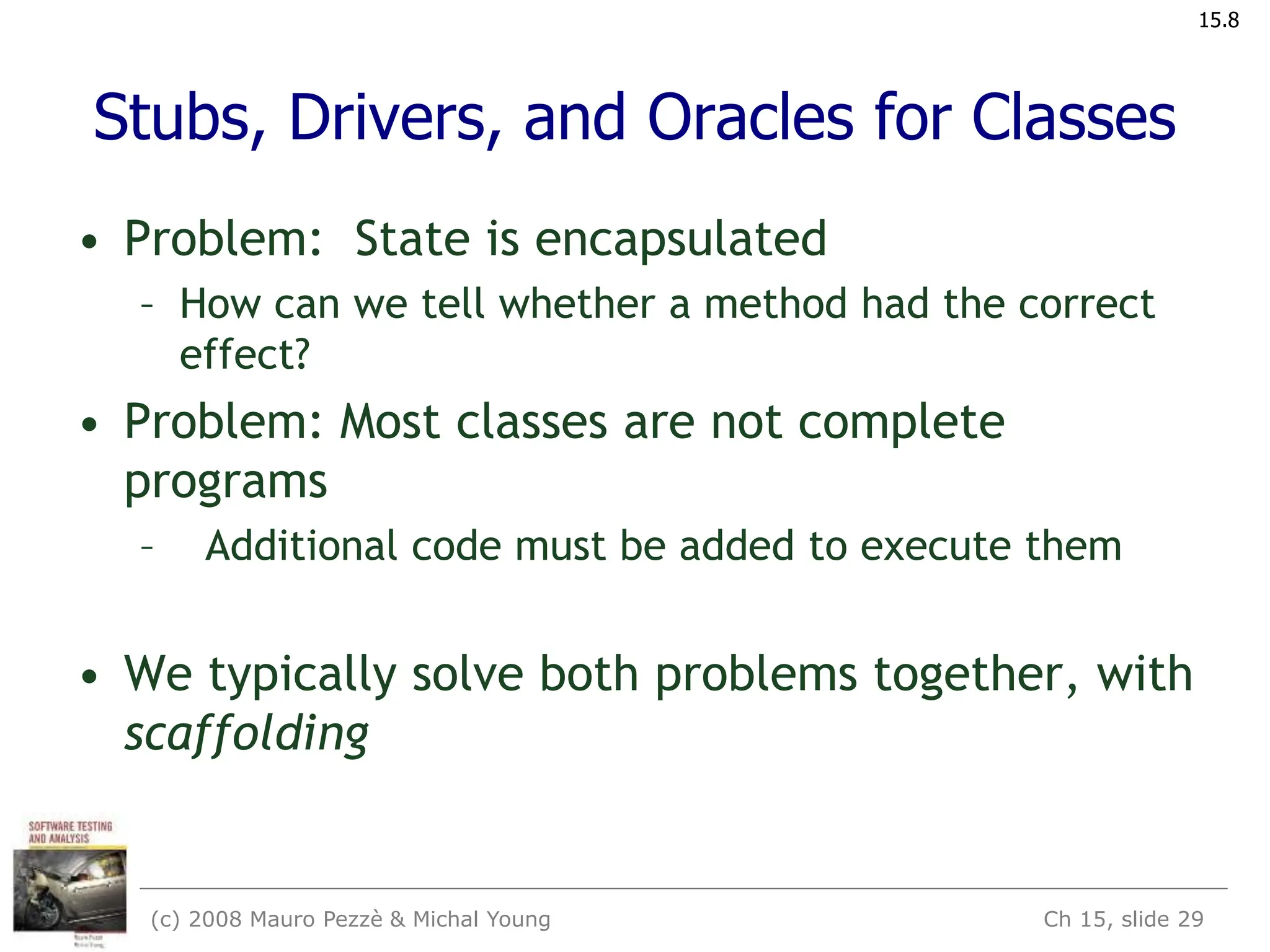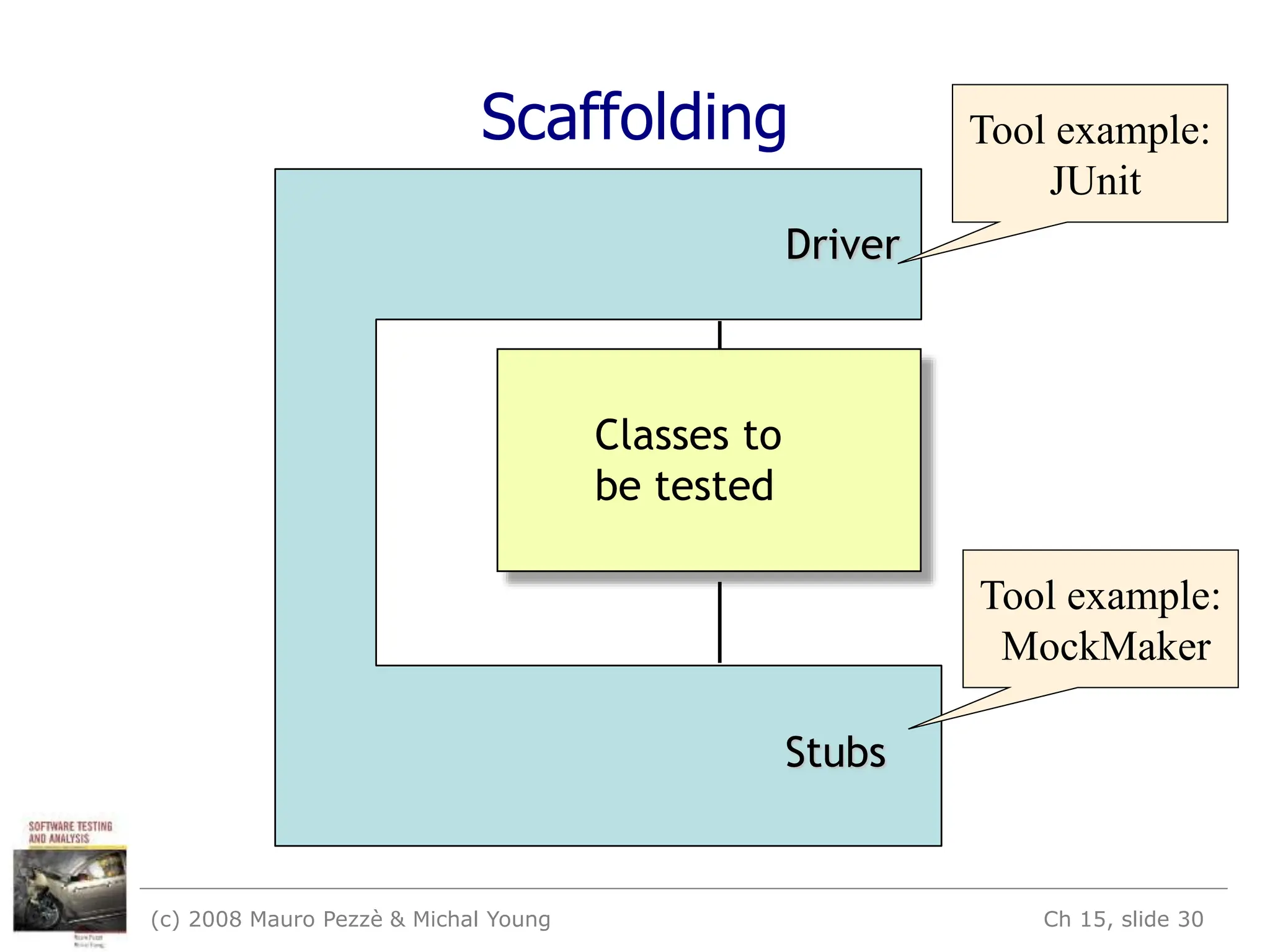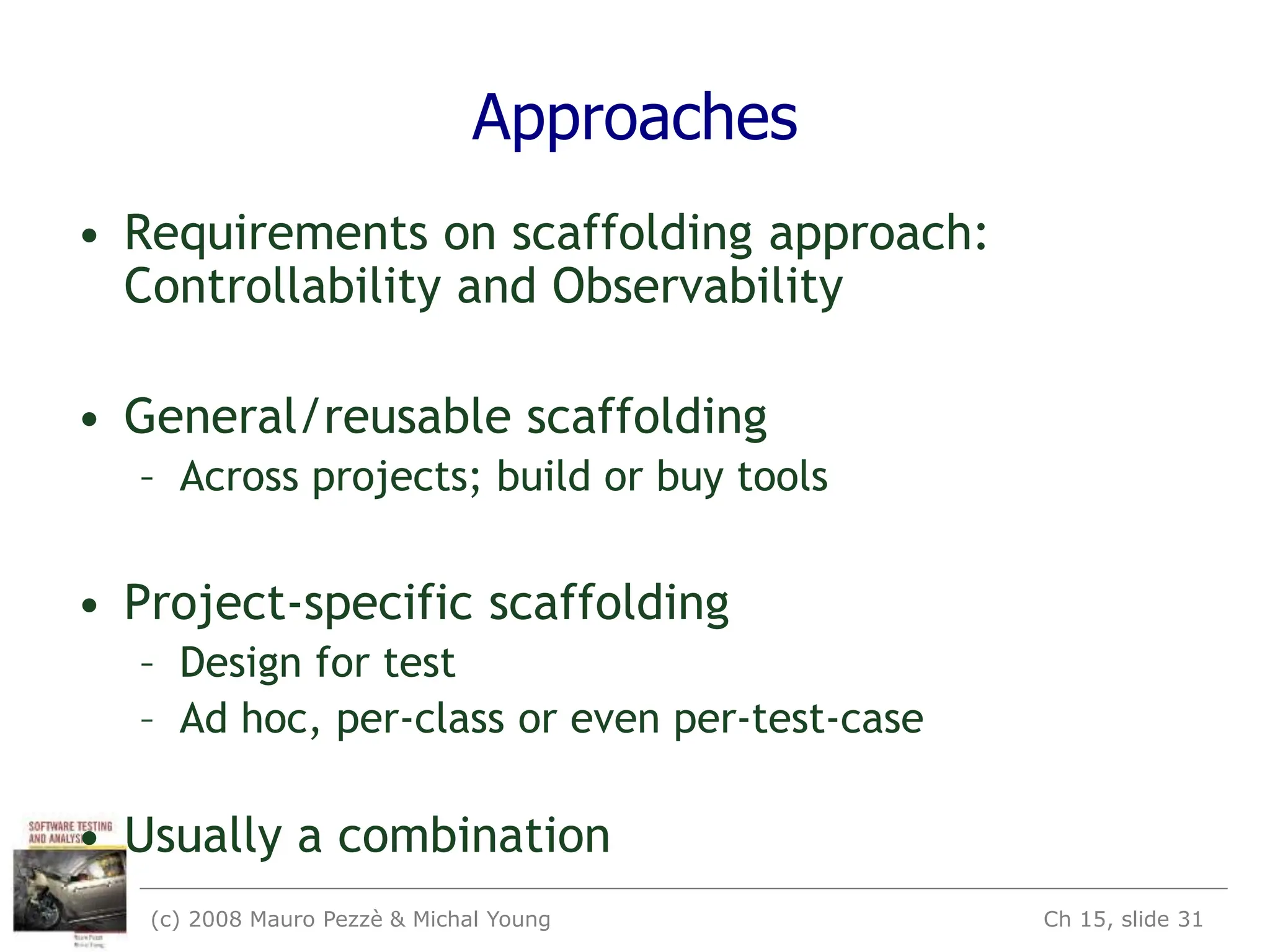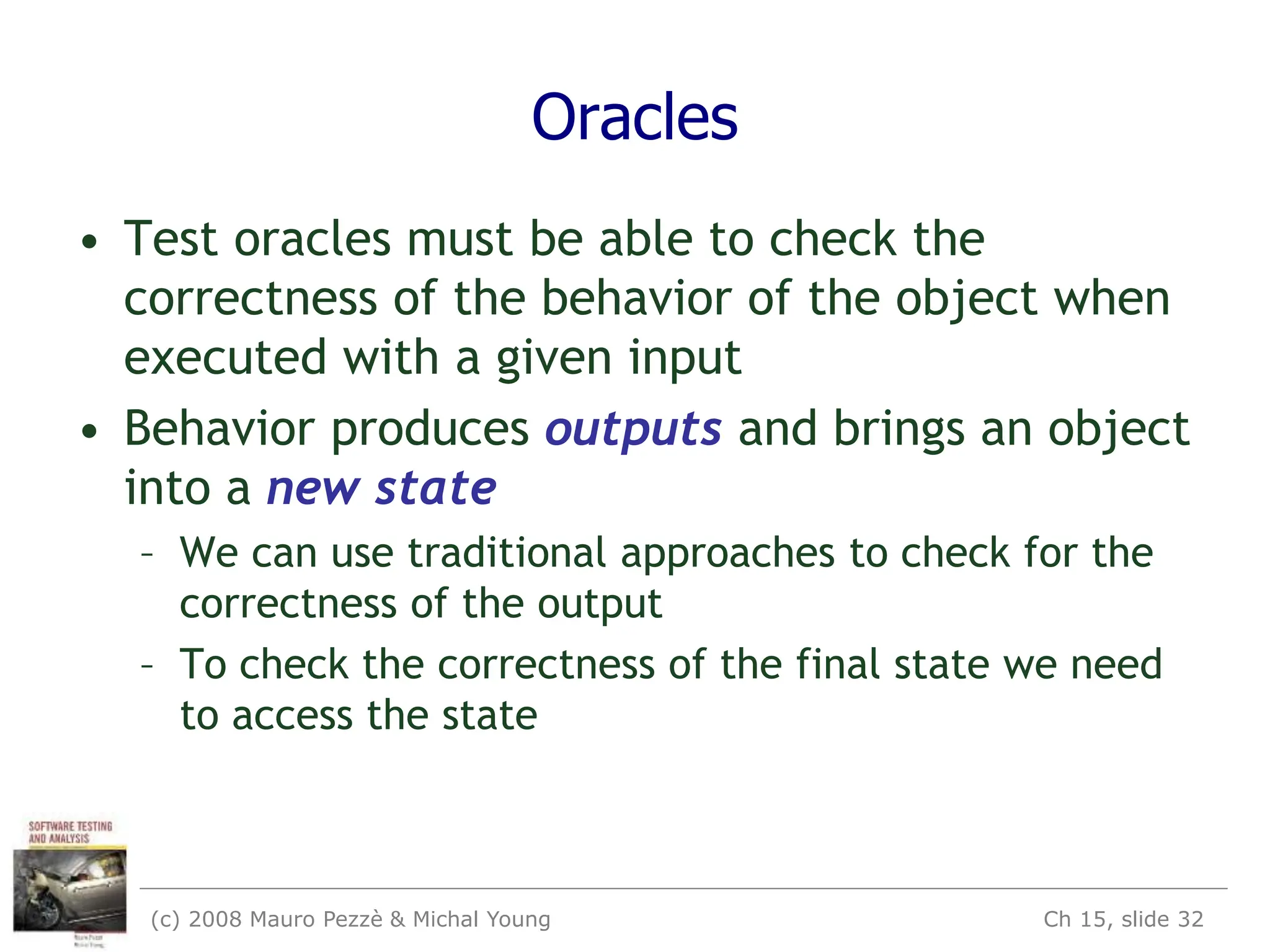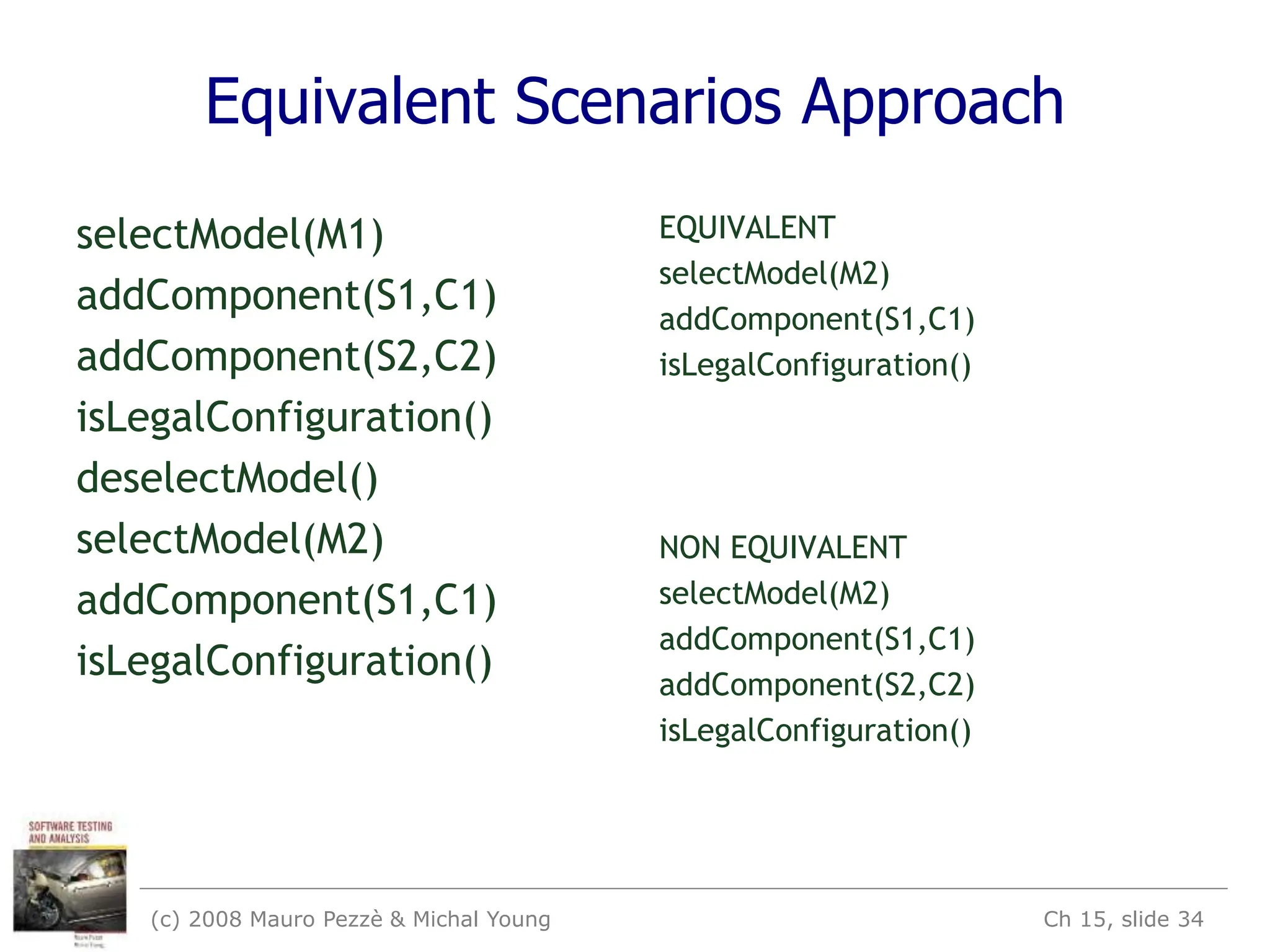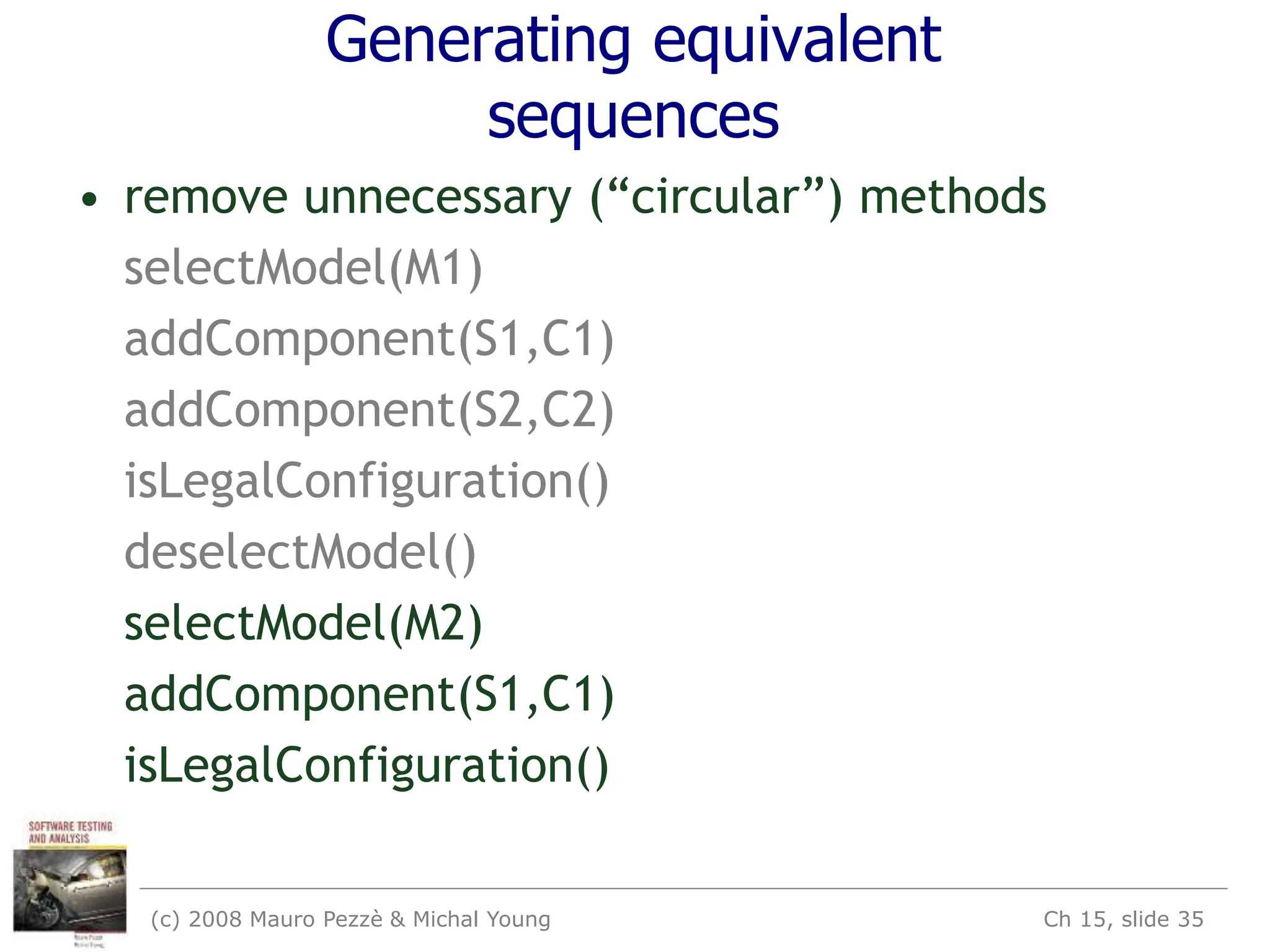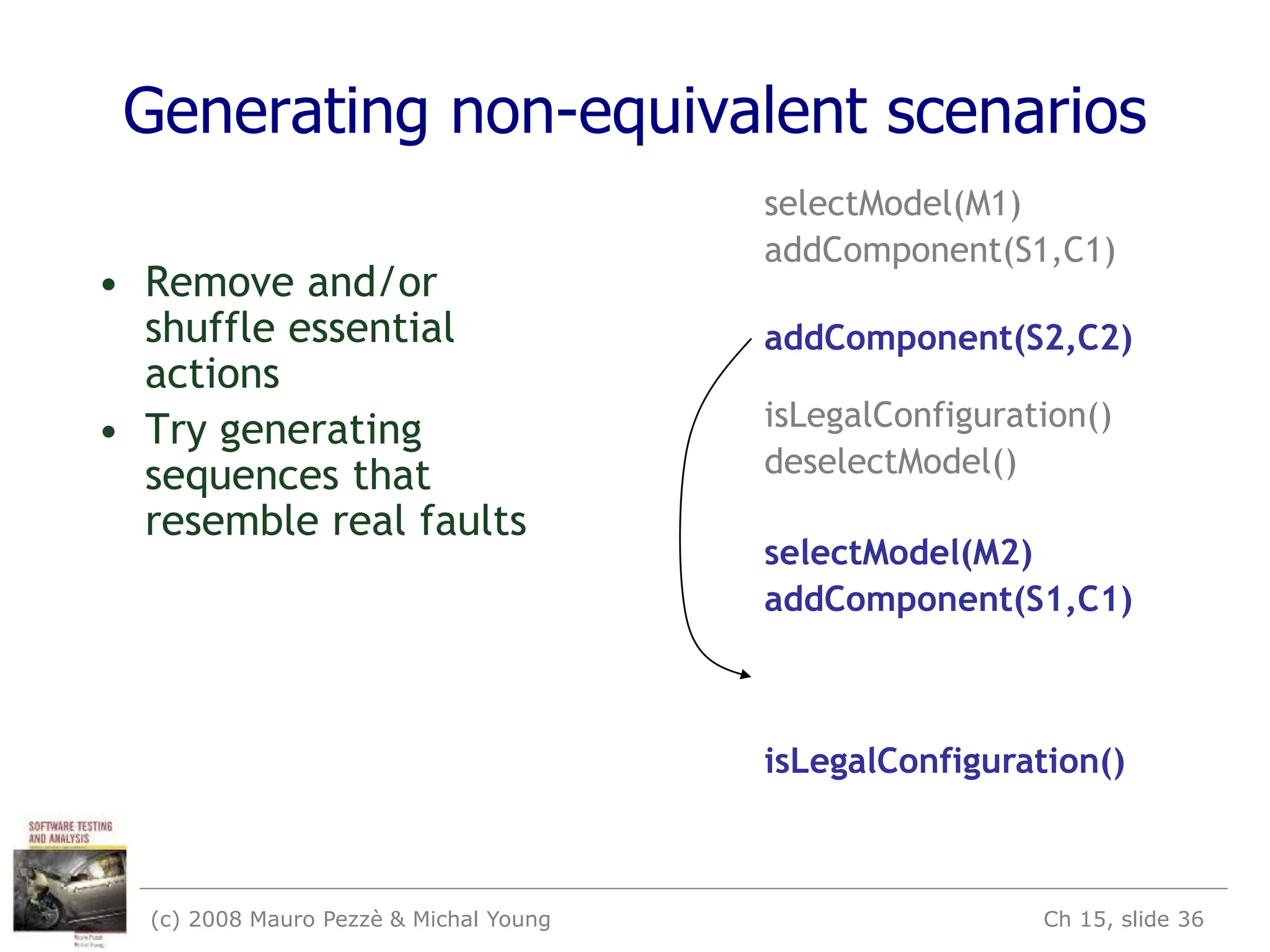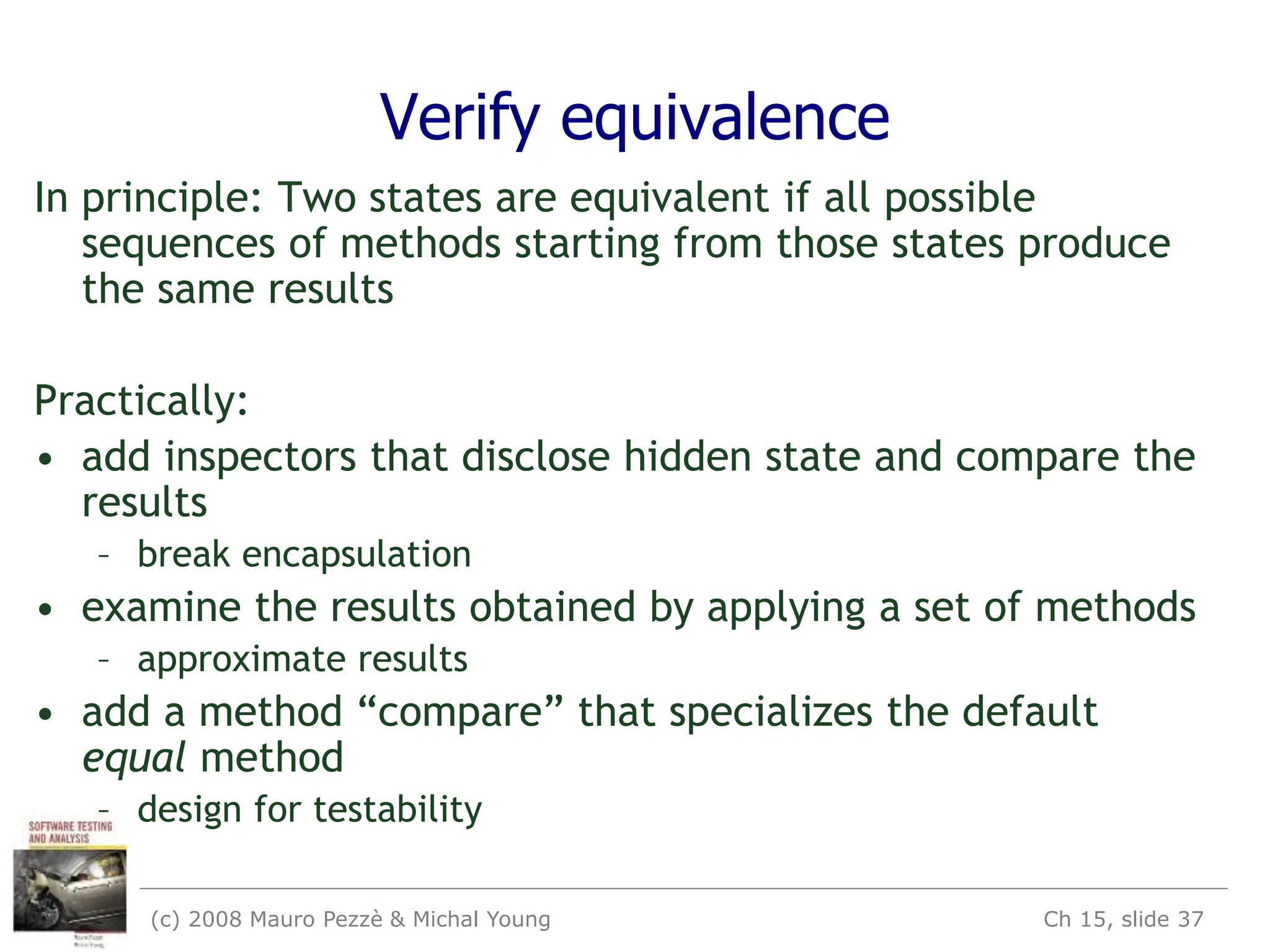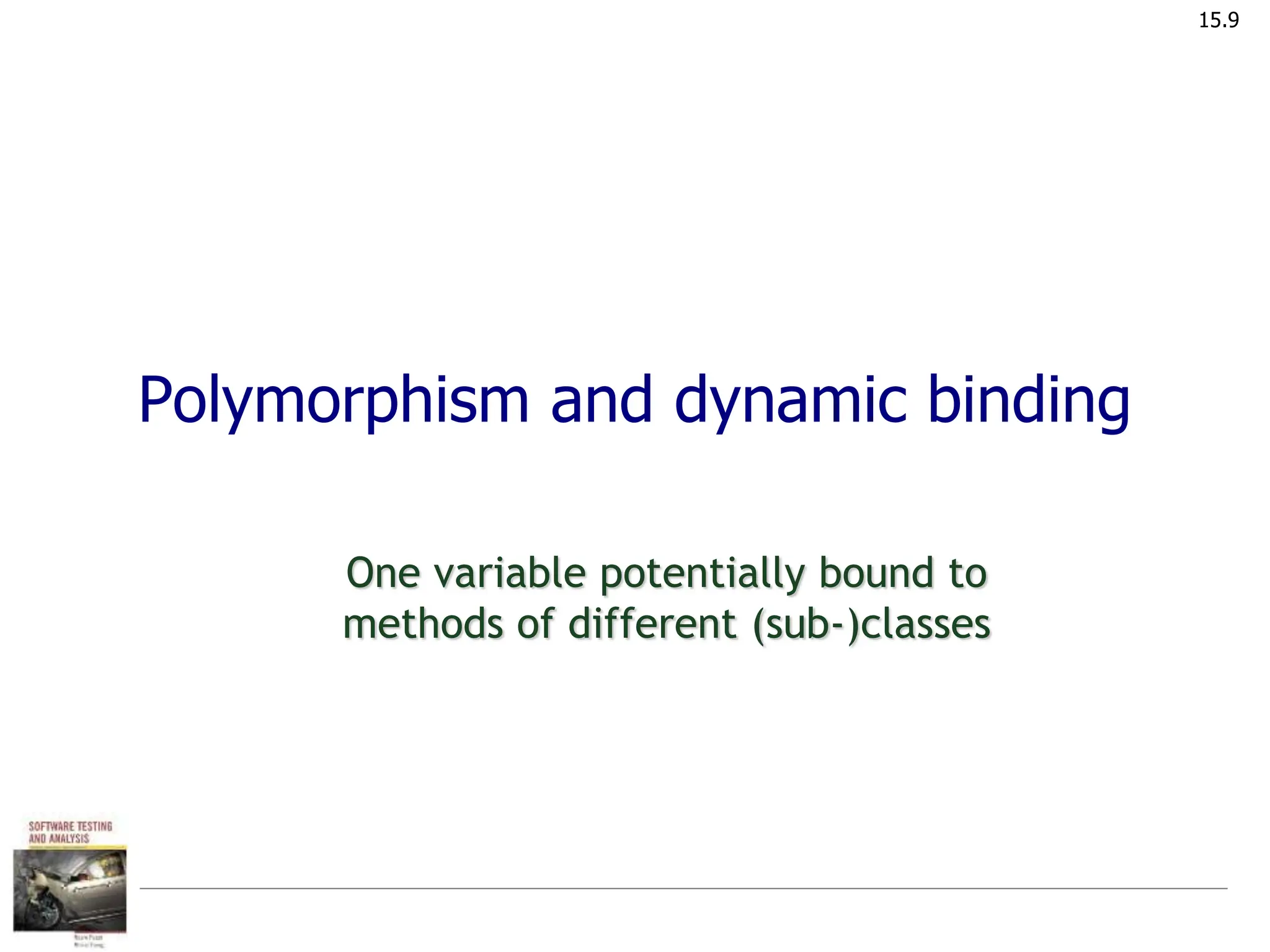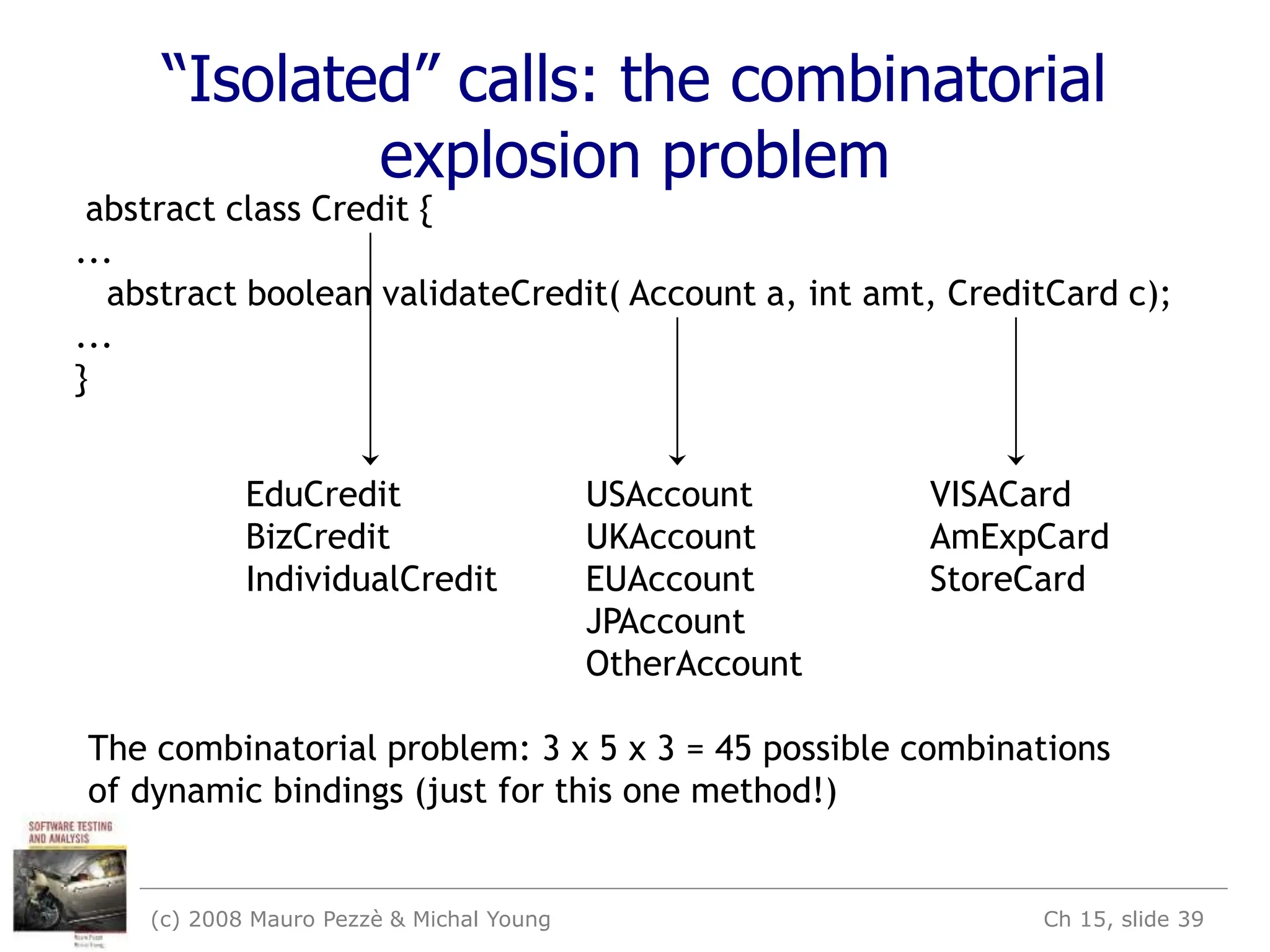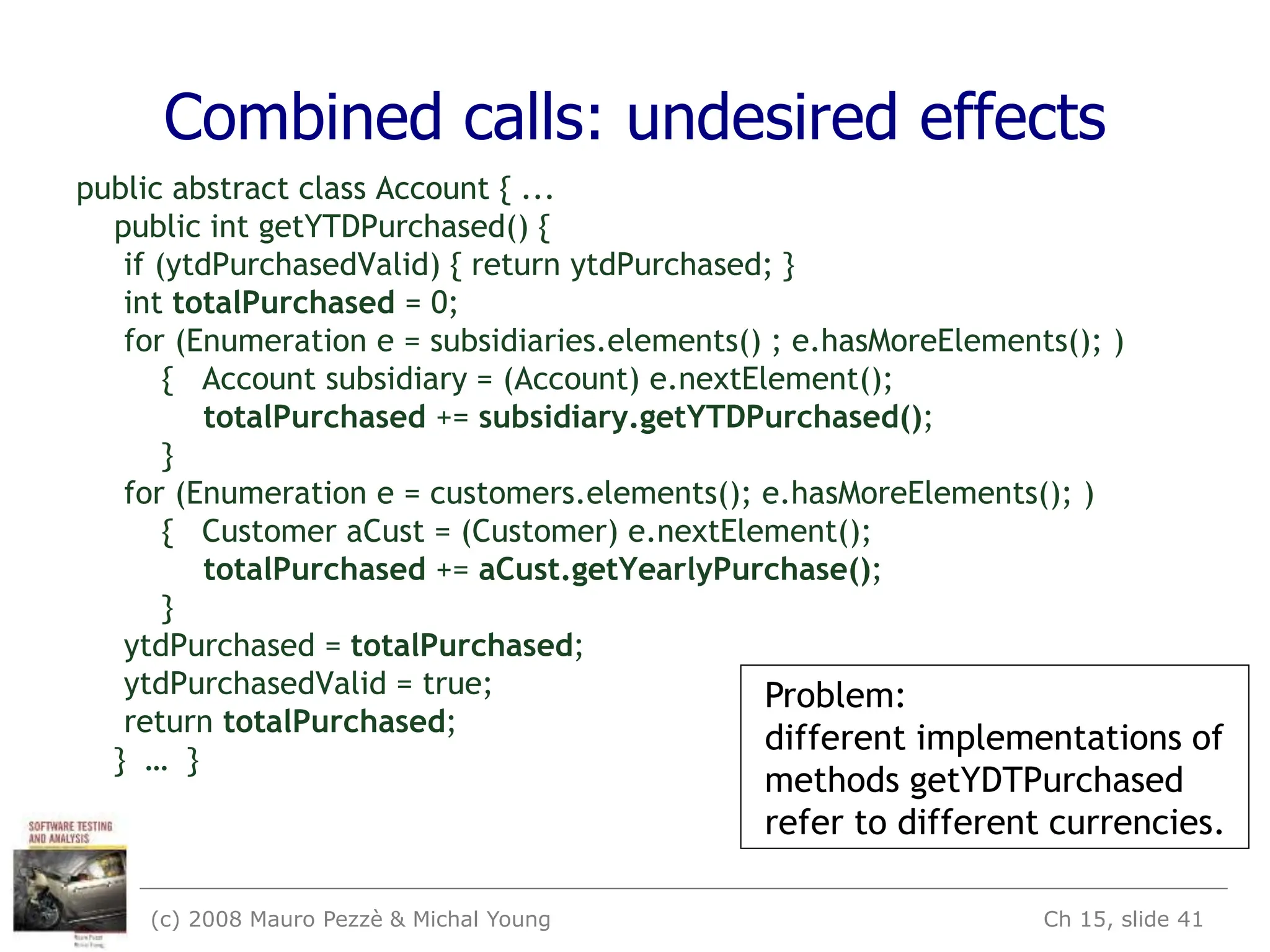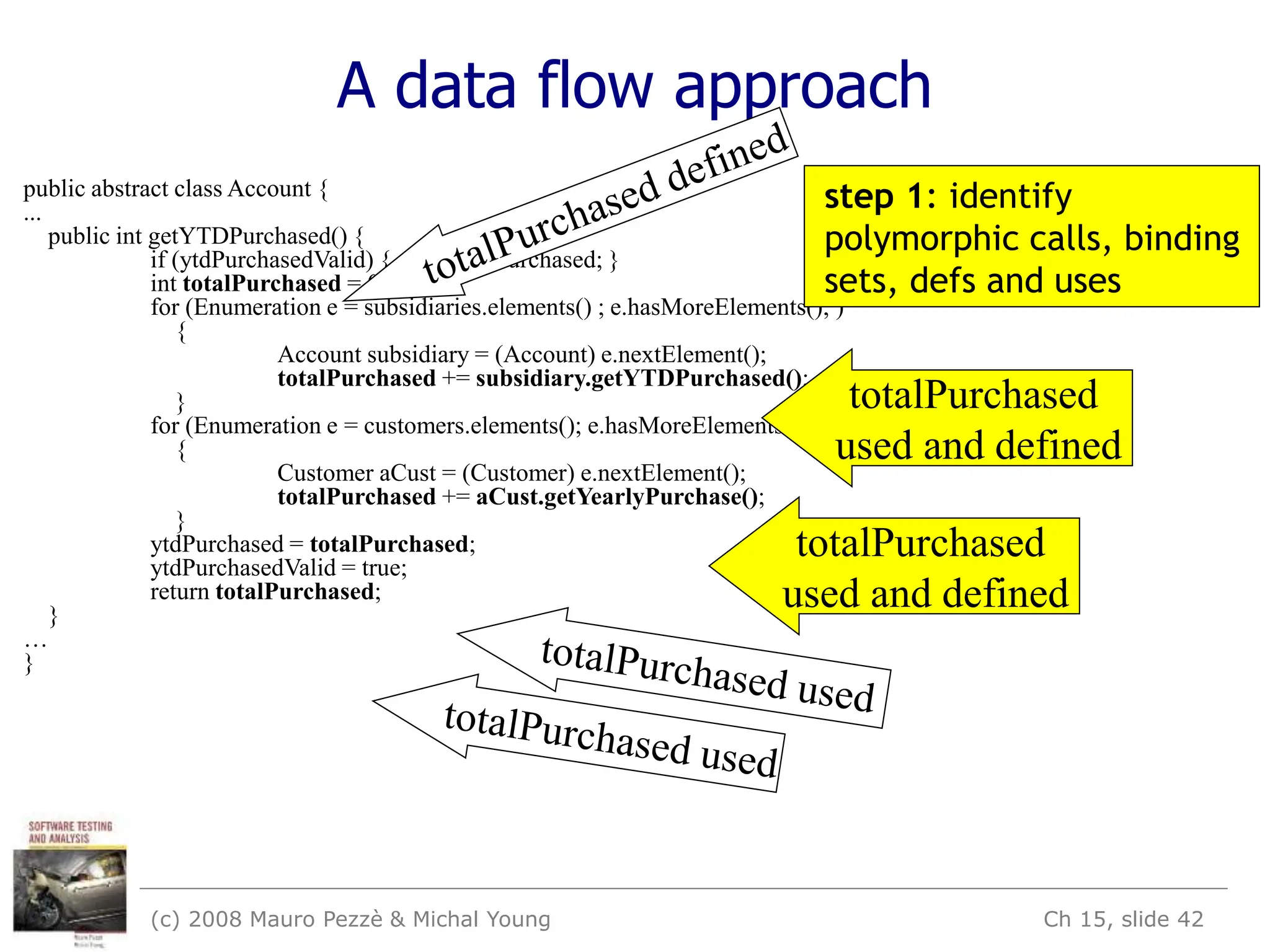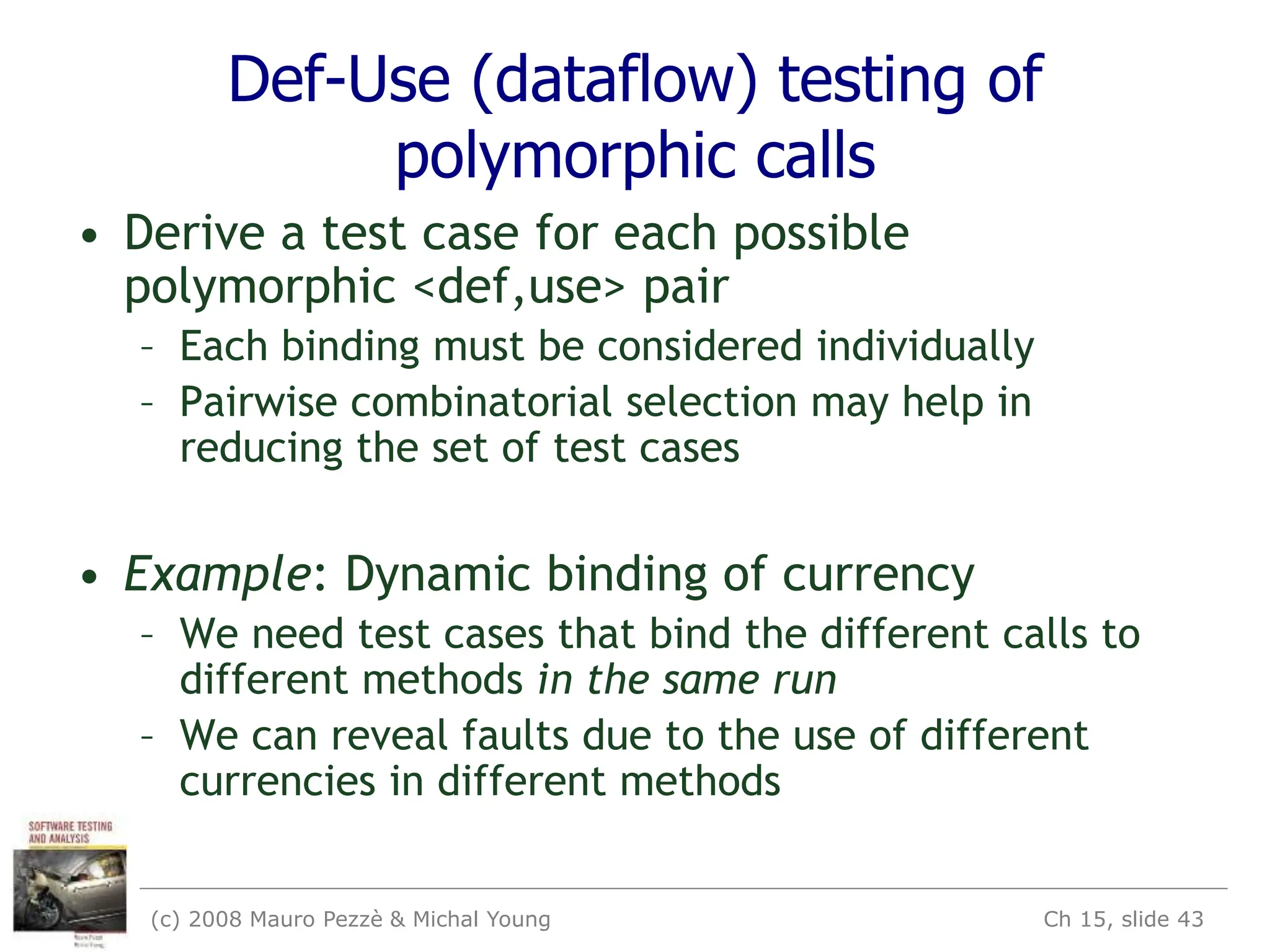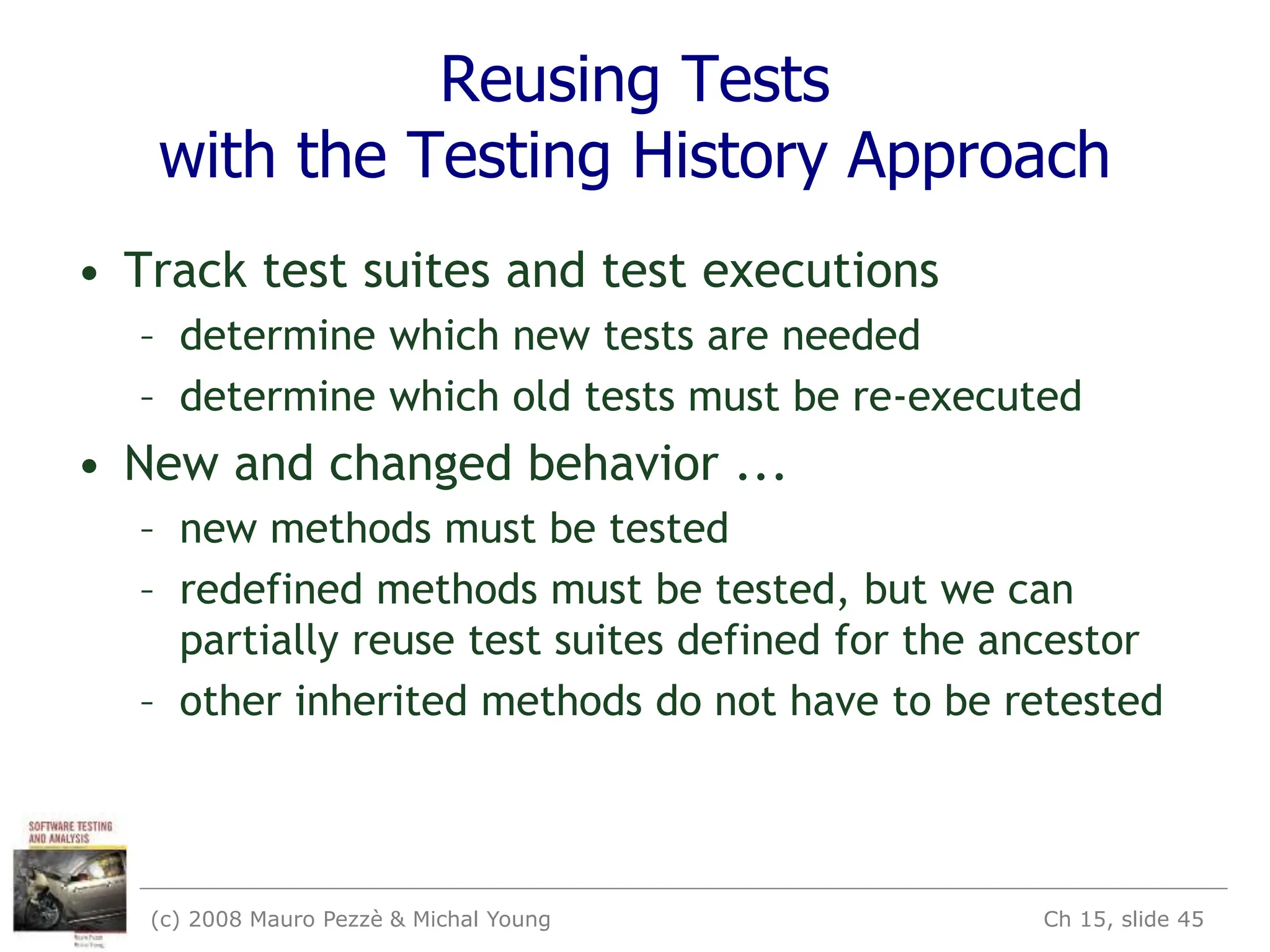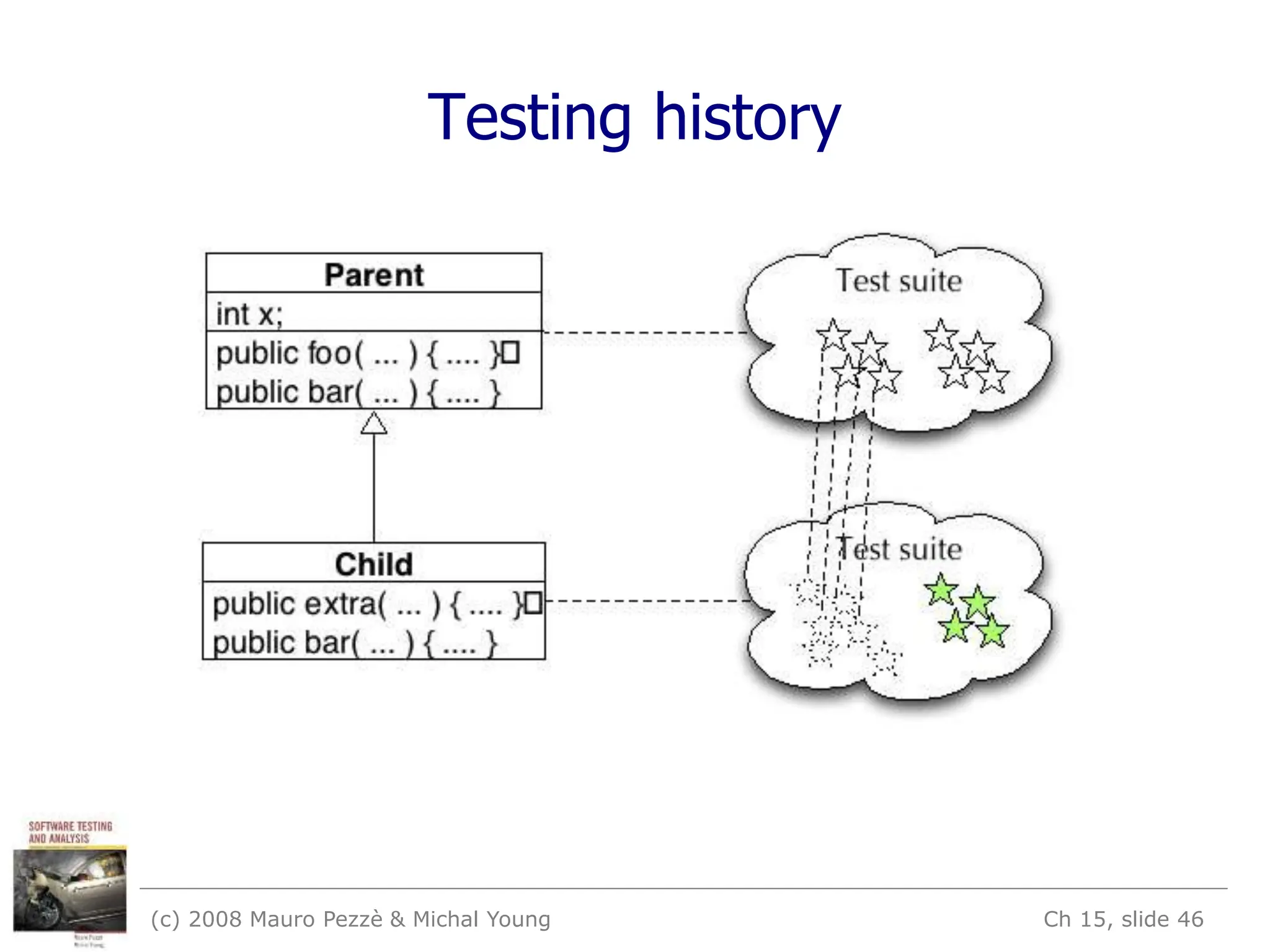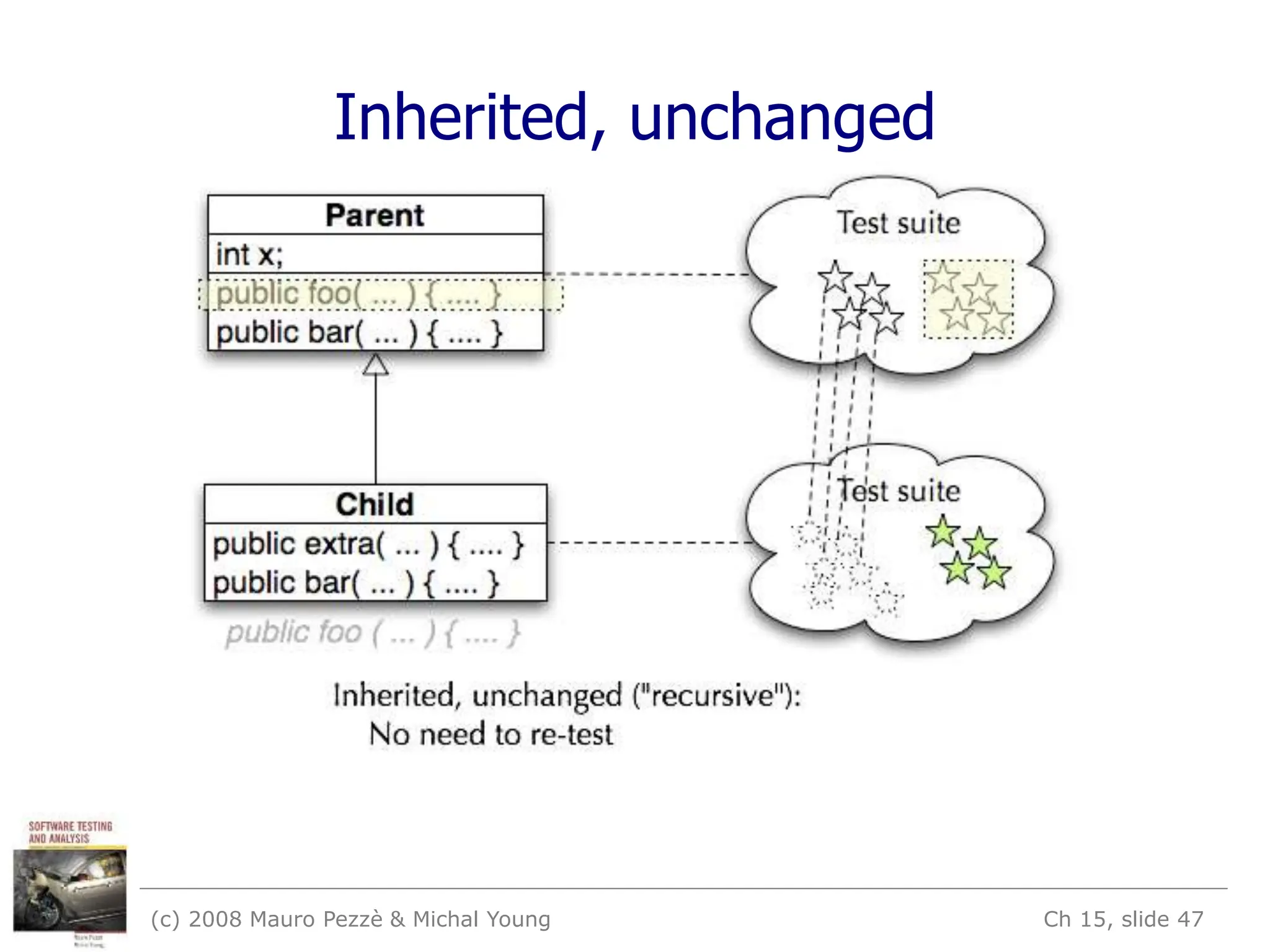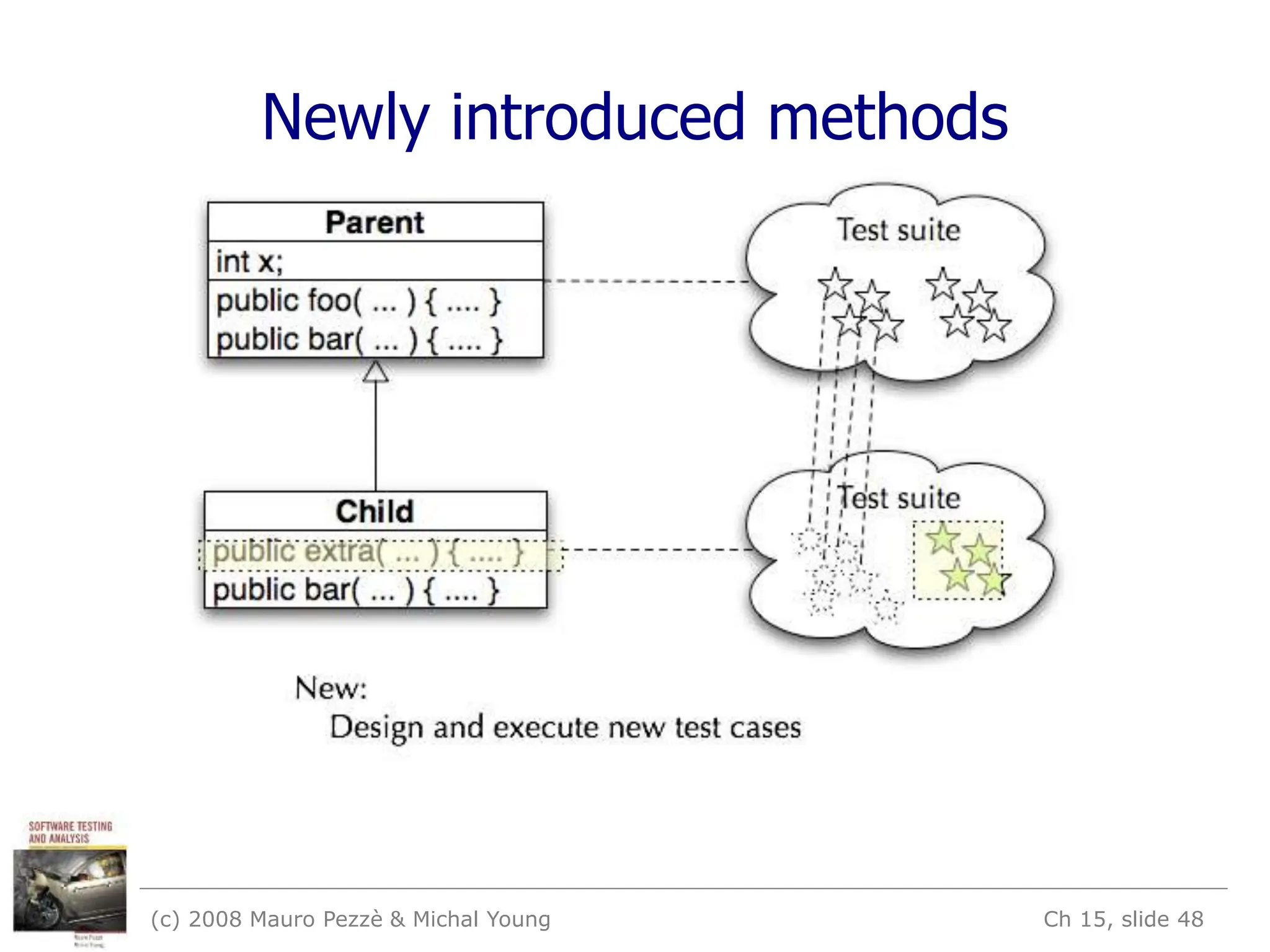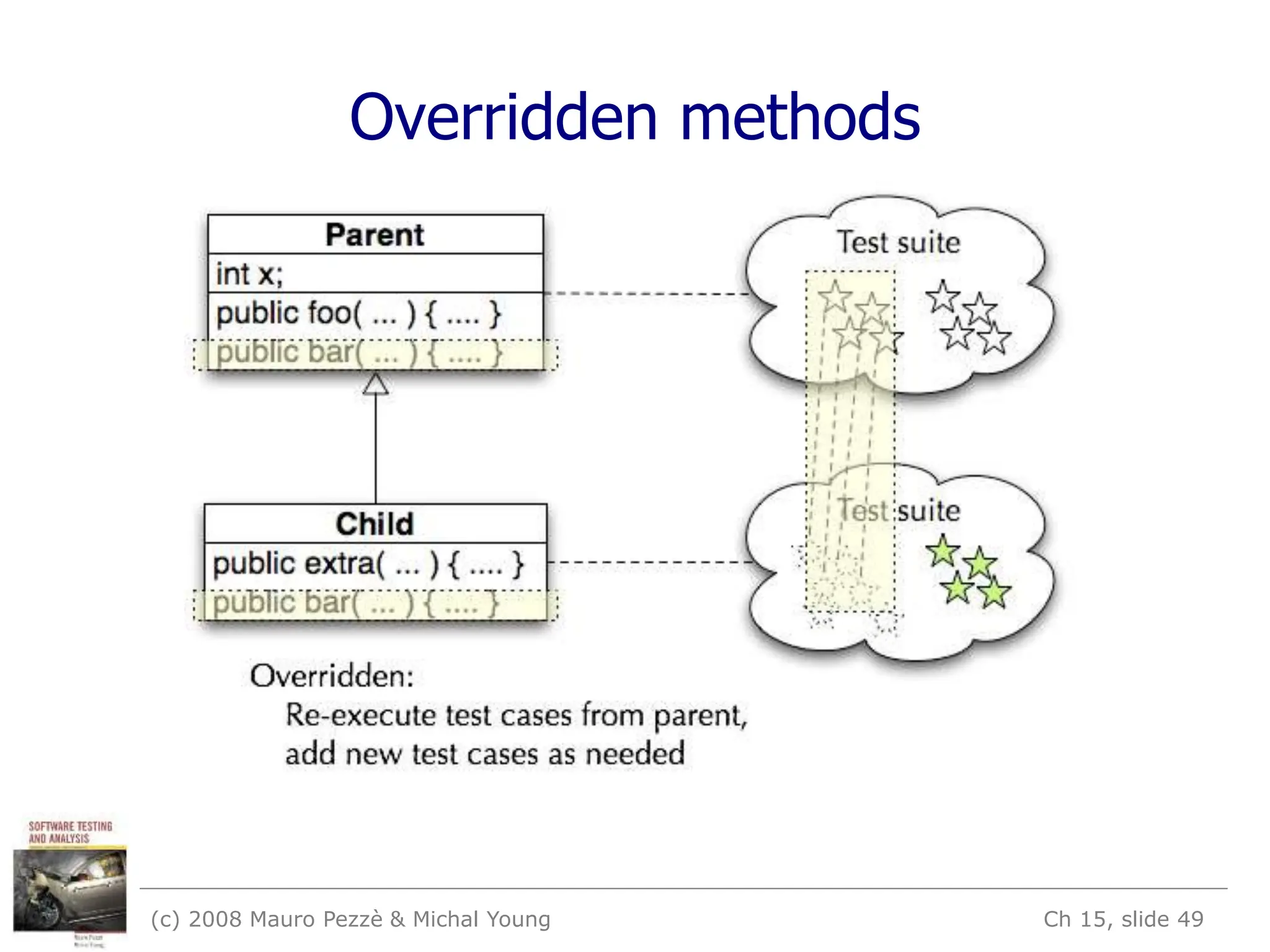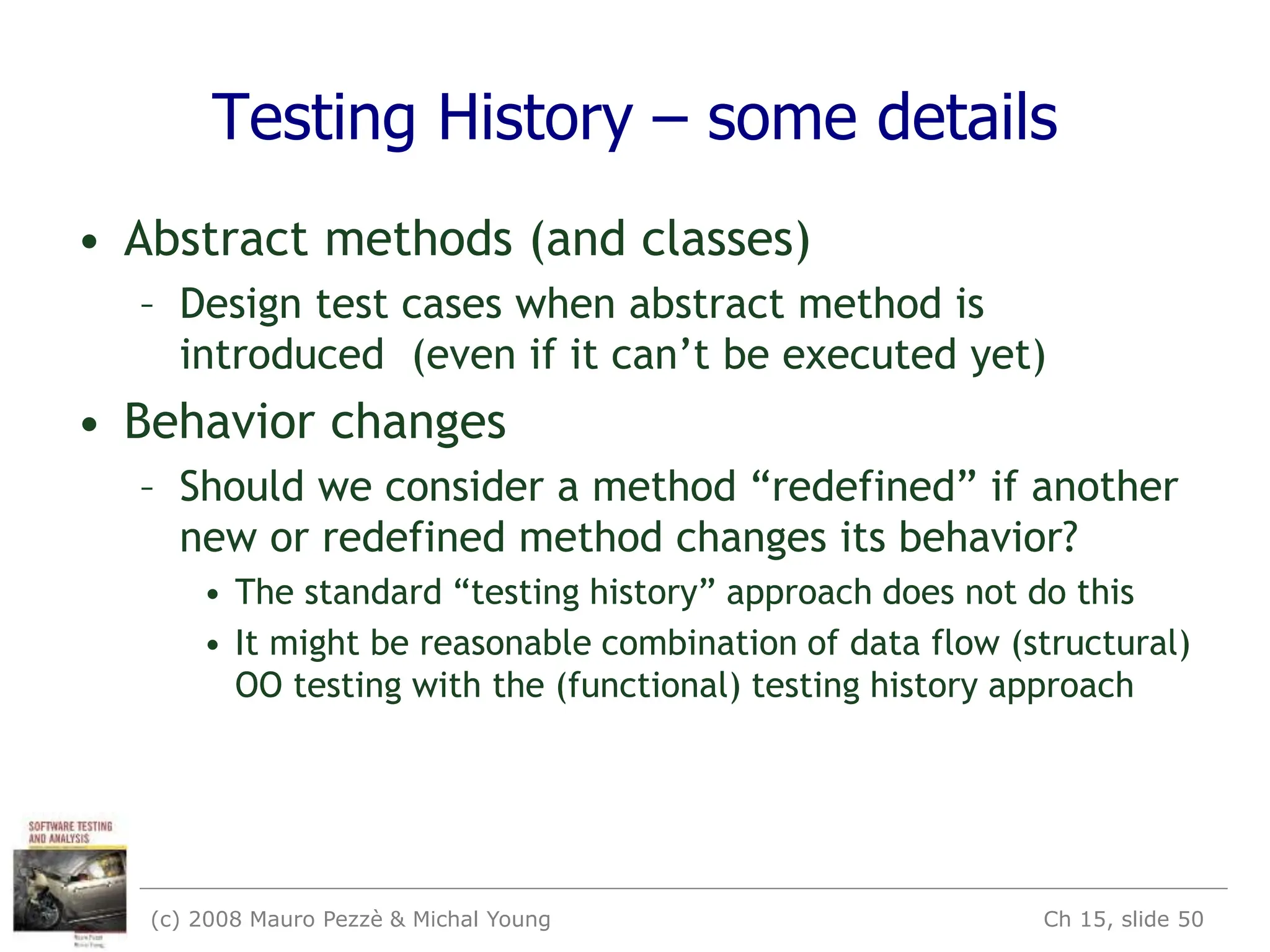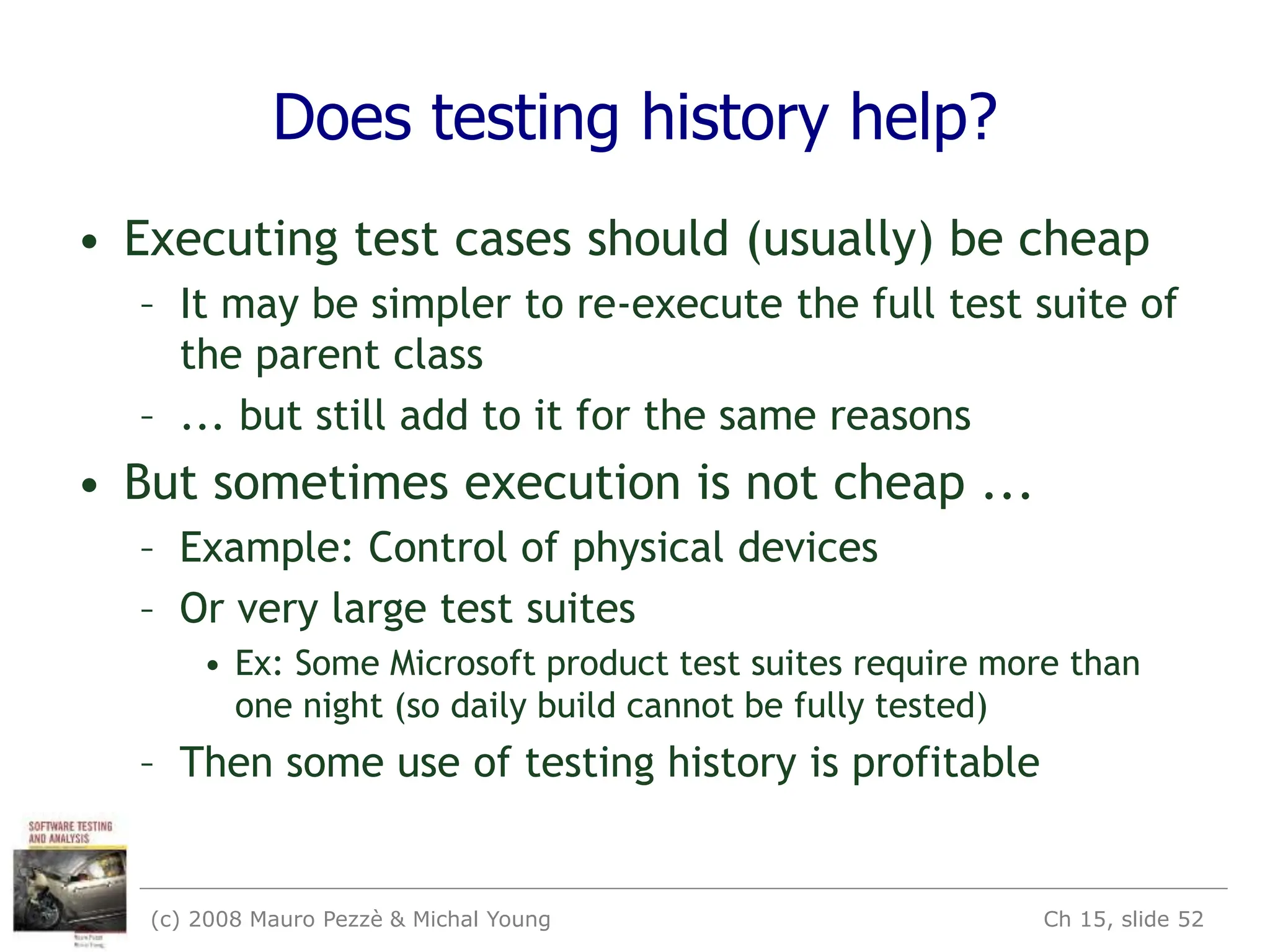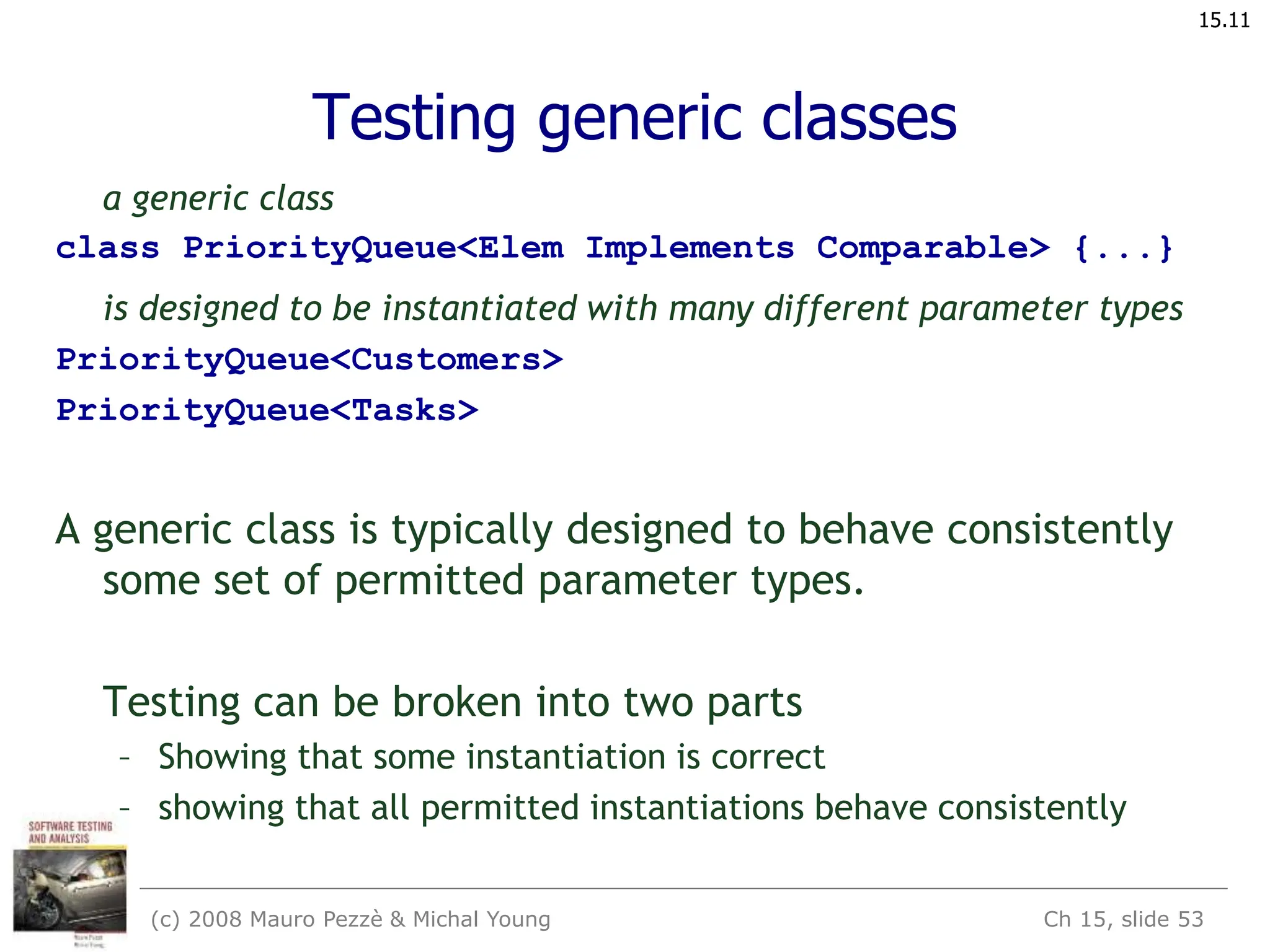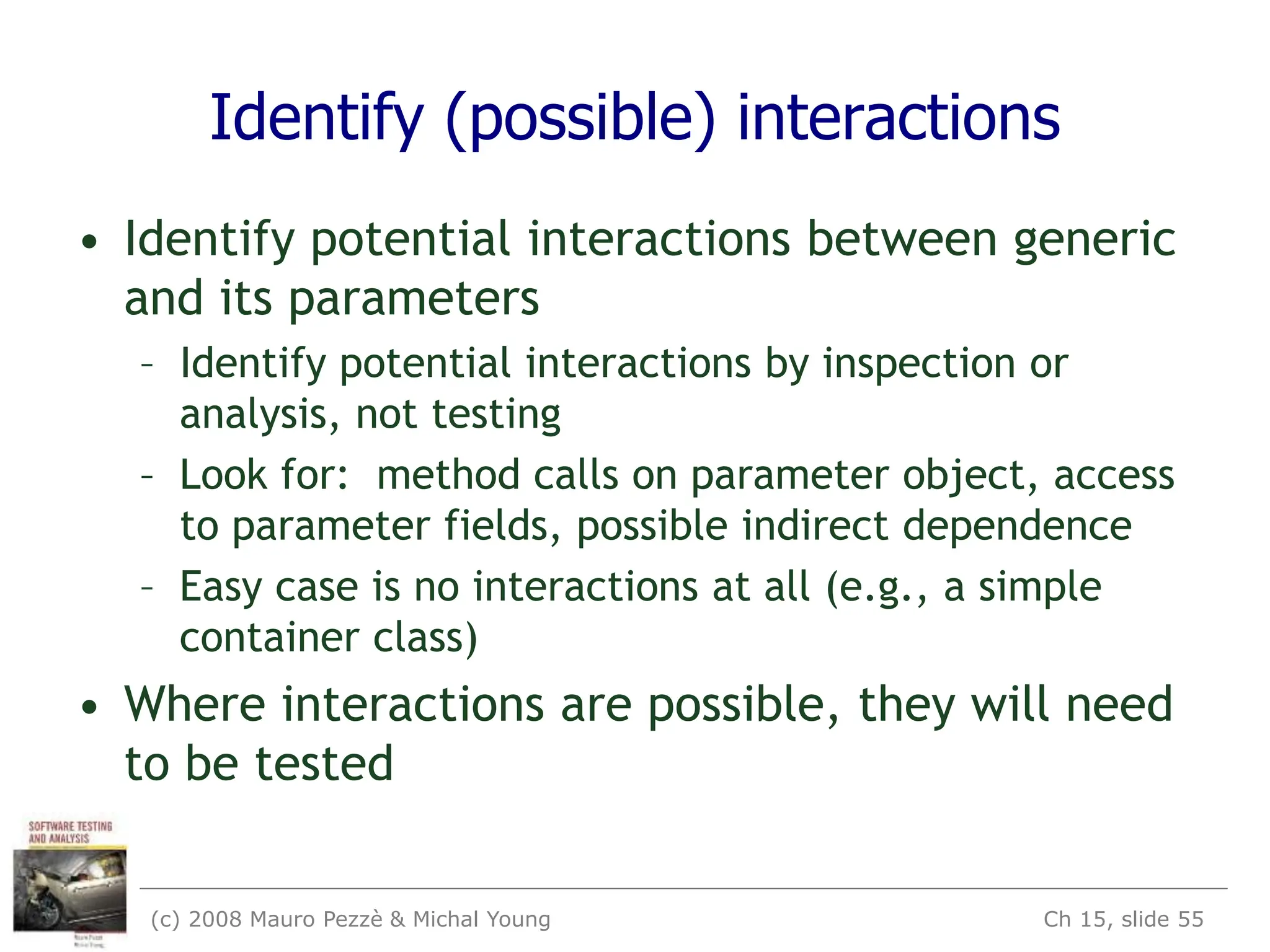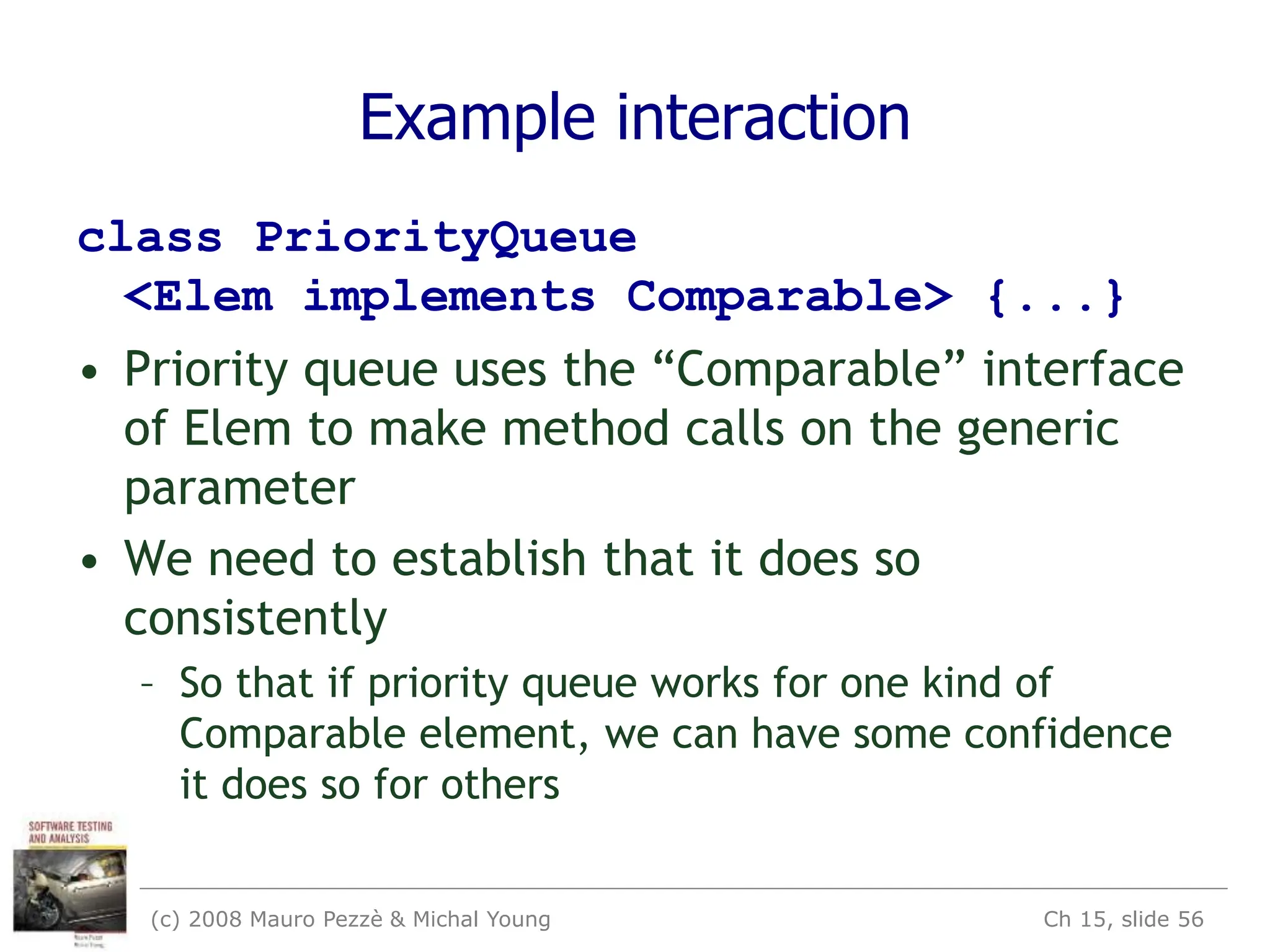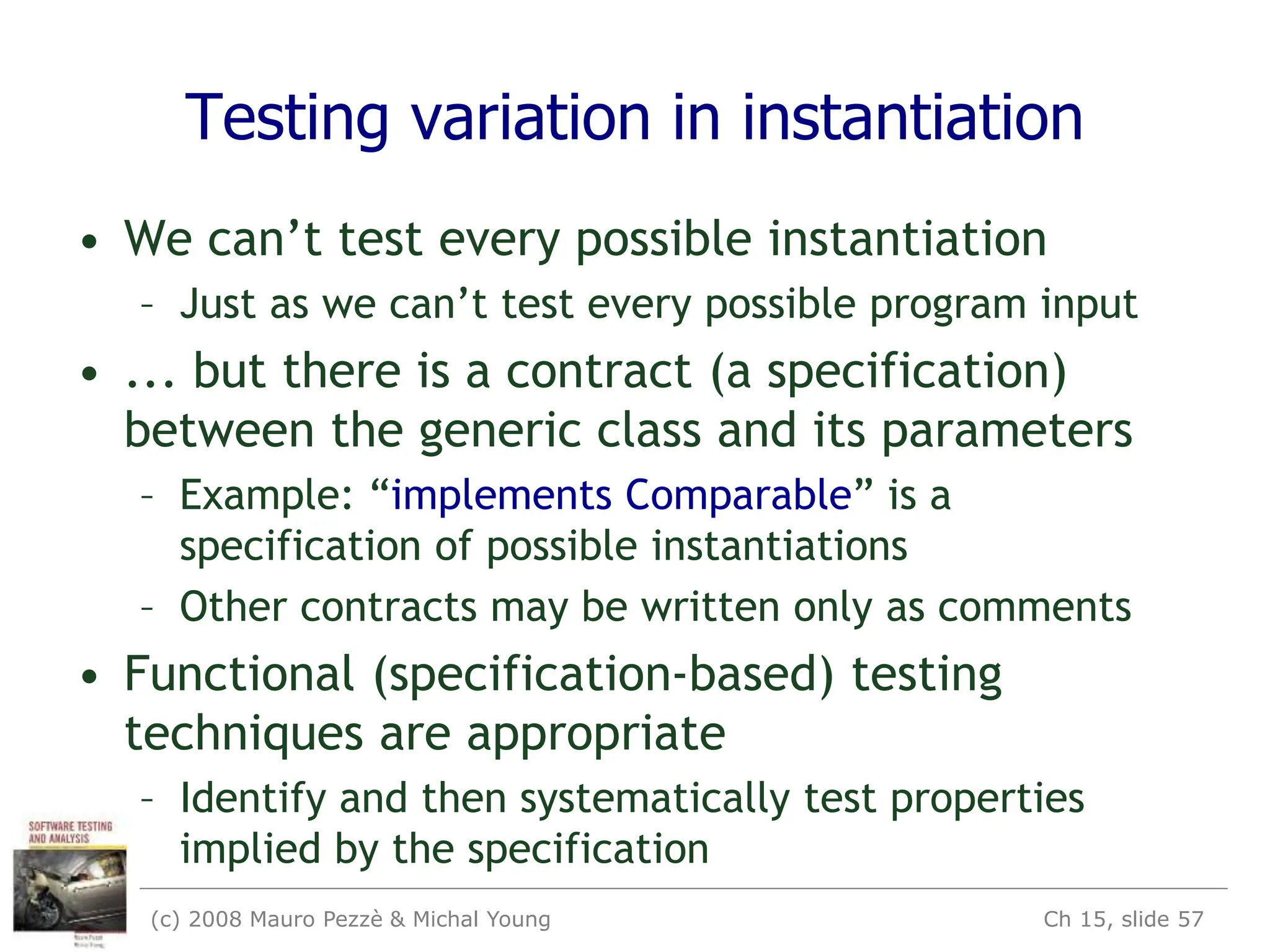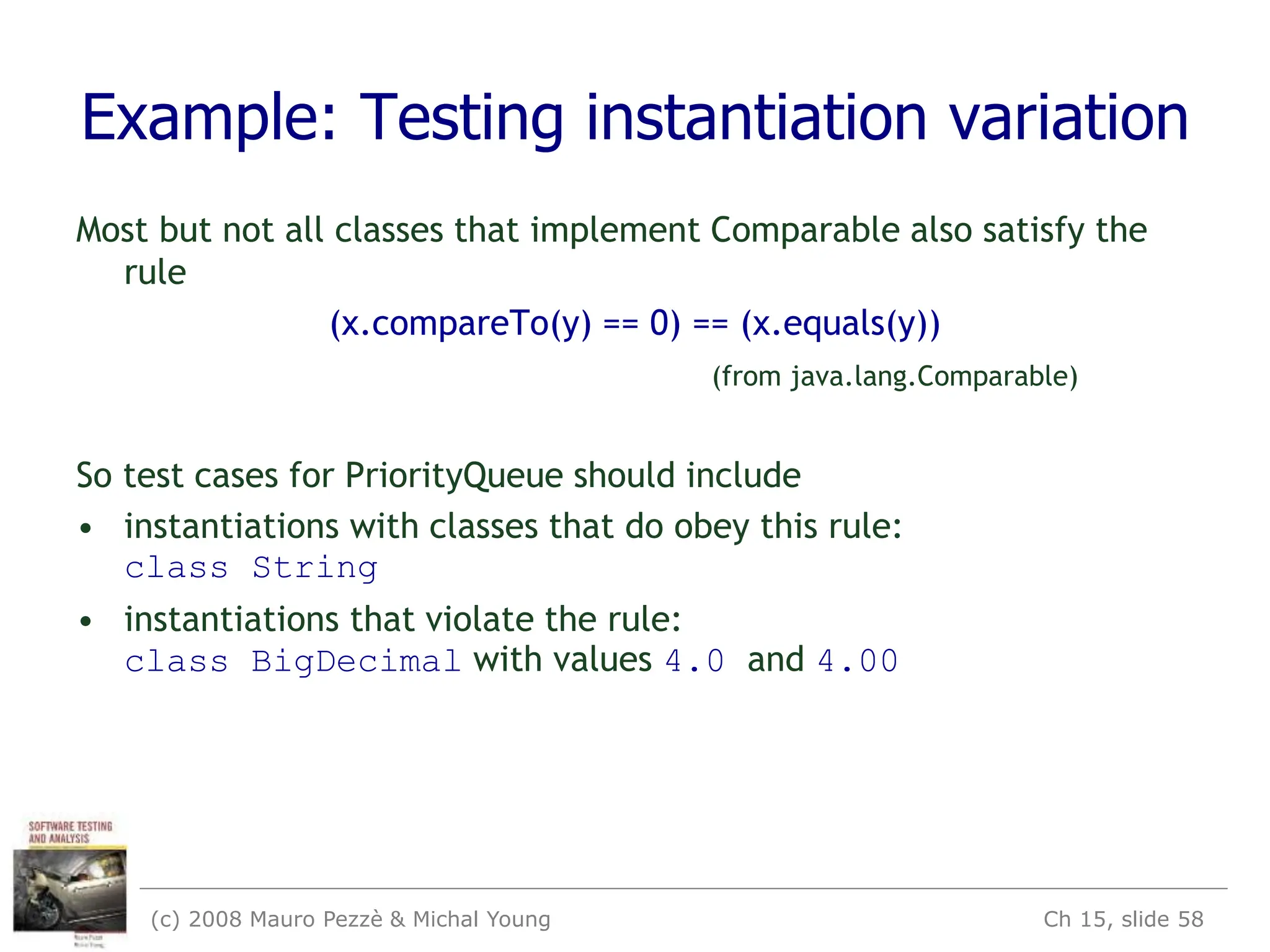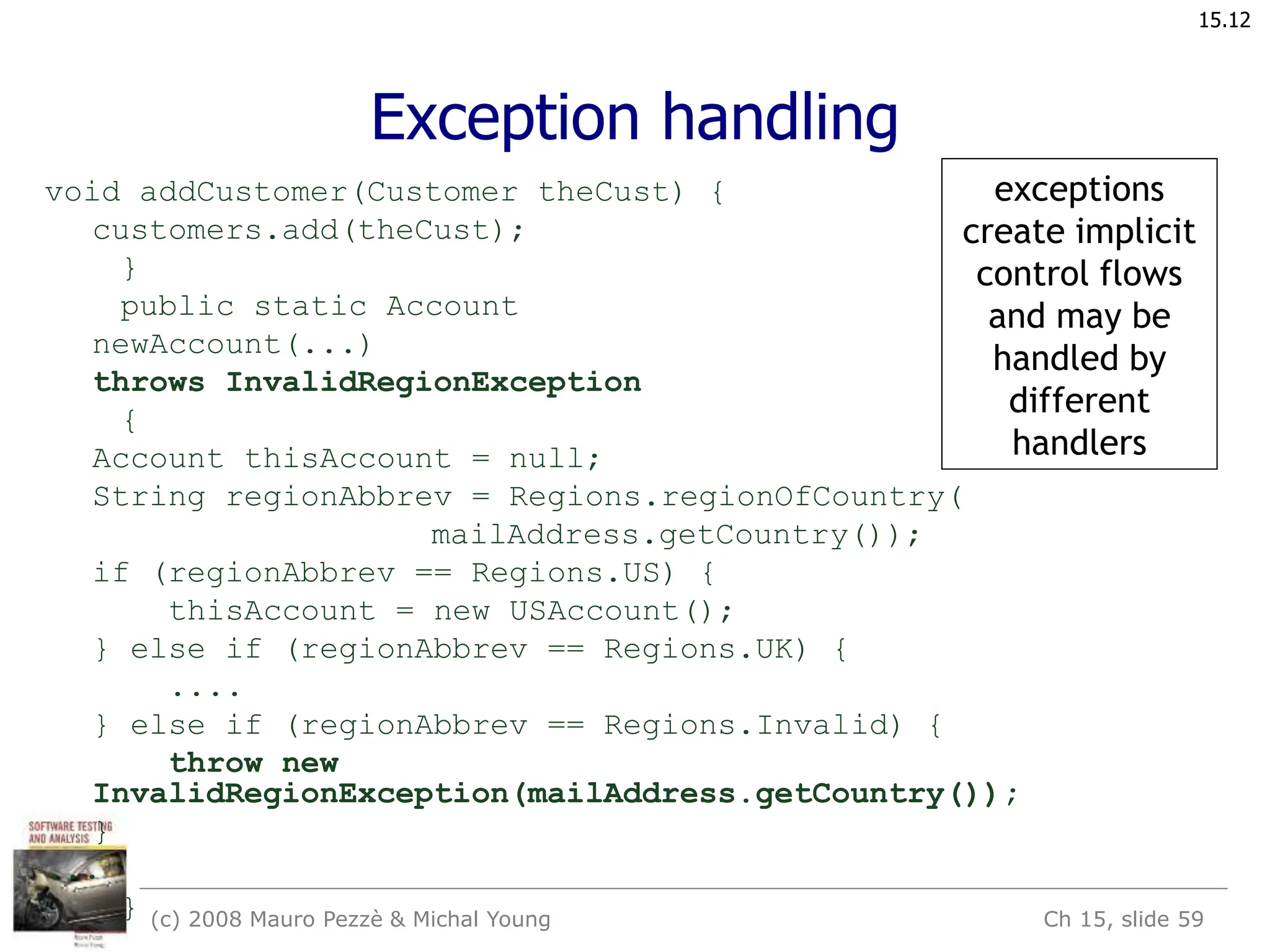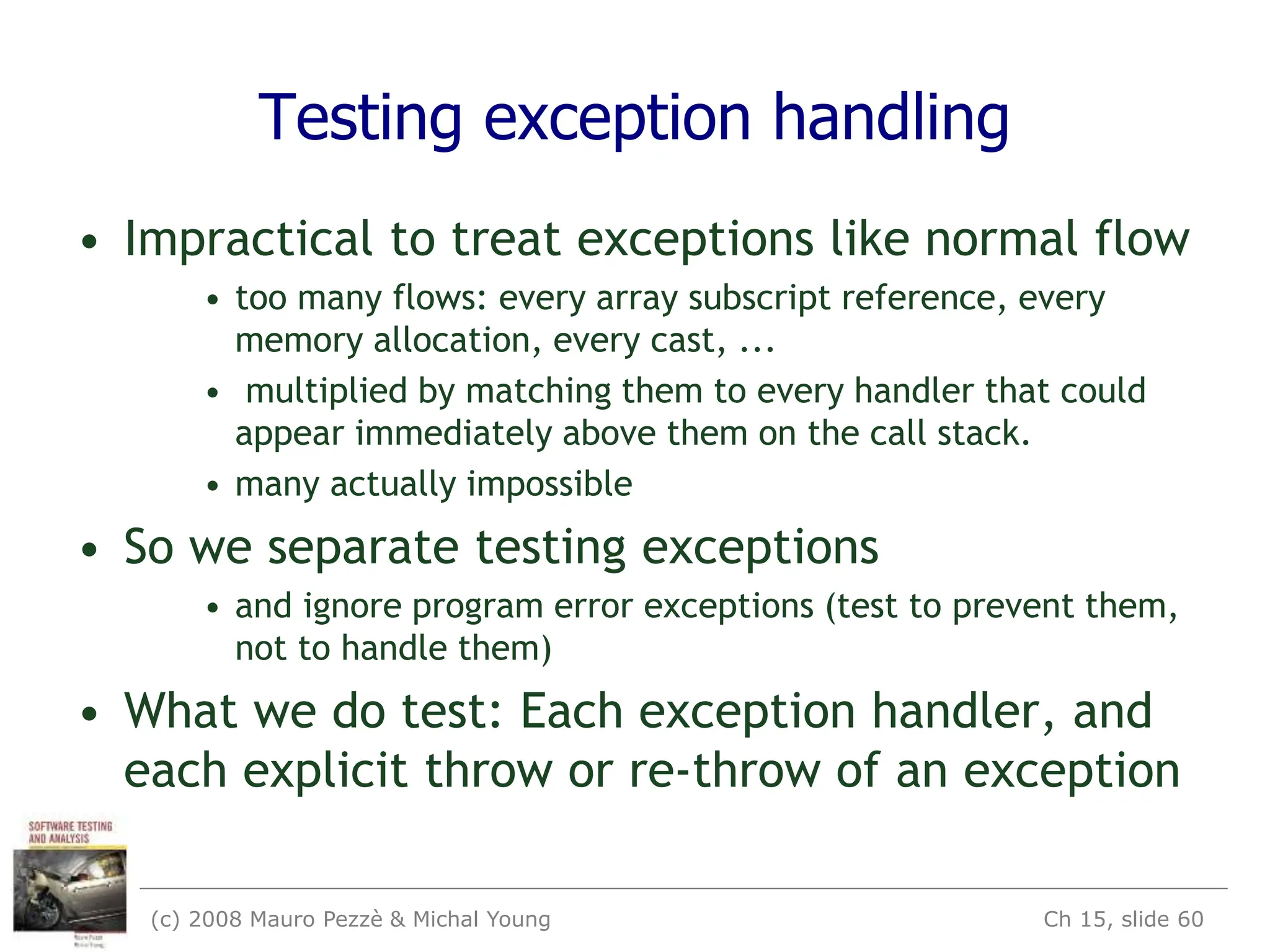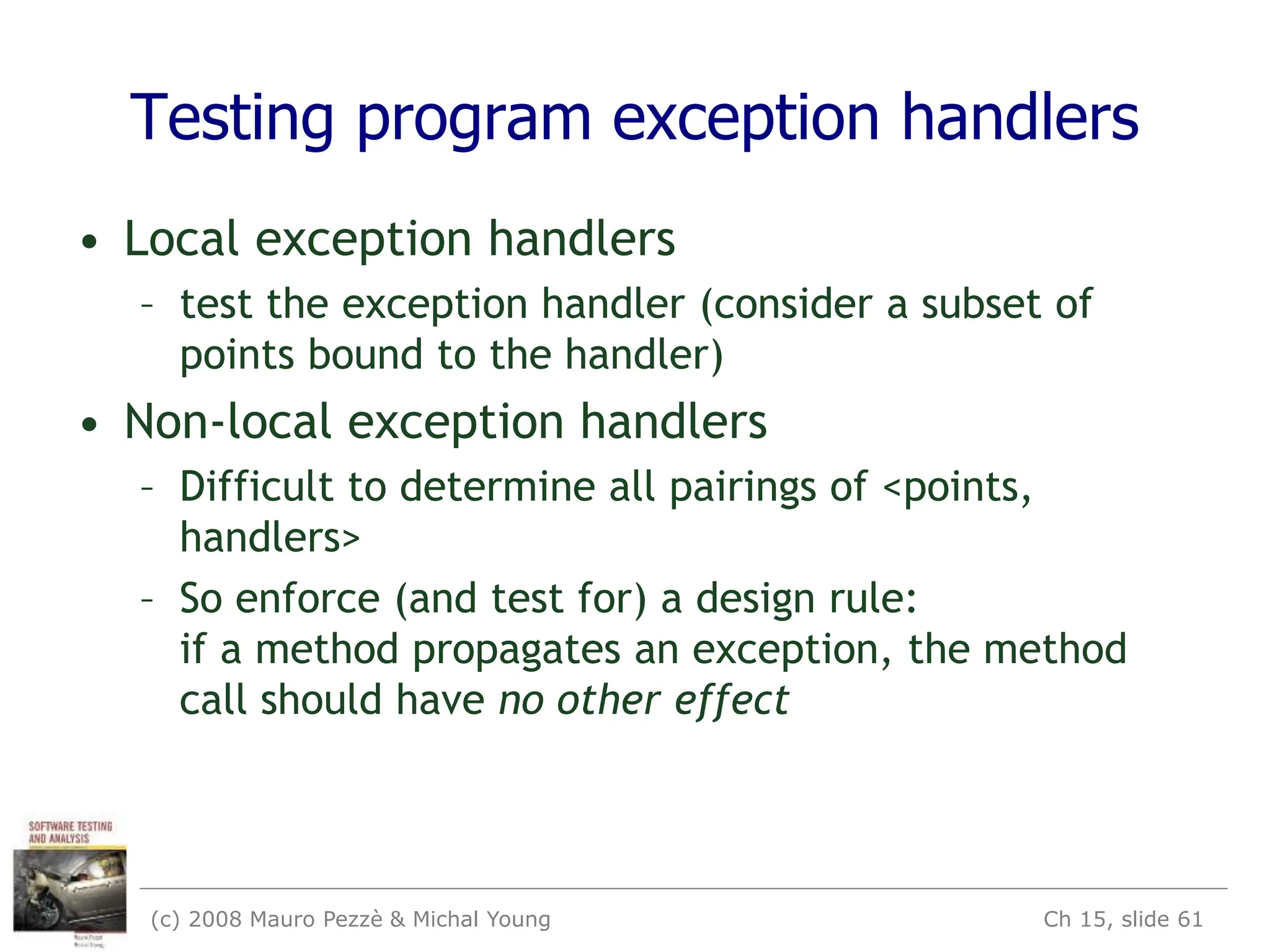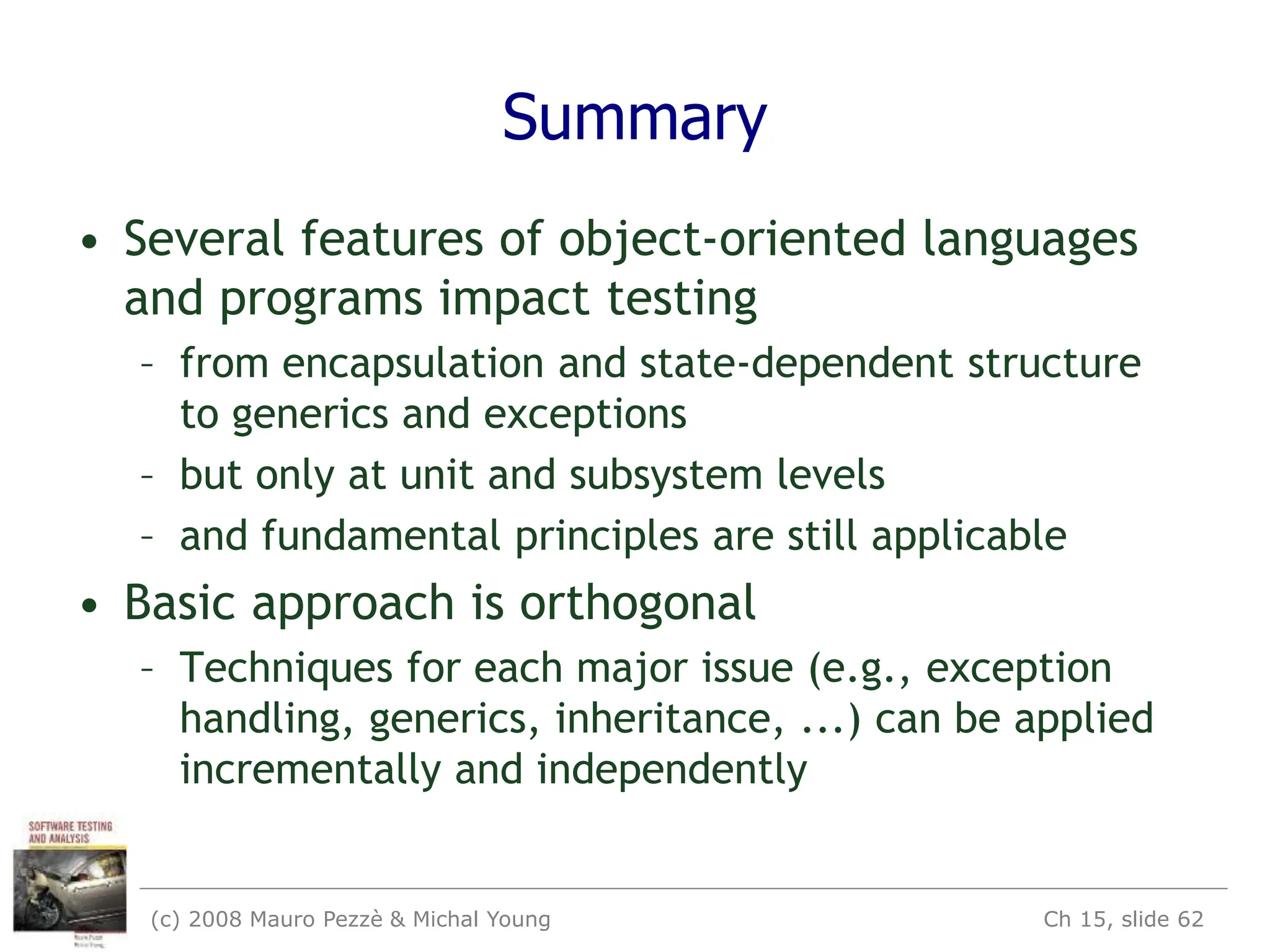This document discusses testing object-oriented software. It covers key characteristics of OO software like encapsulation and polymorphism that impact testing. It discusses unit testing at the class level and integration testing between classes. It also describes techniques for testing state-dependent behavior using state machines and structural testing using control flow graphs and definition-use pairs. Scaffolding with drivers, stubs and oracles is needed to test classes in isolation.


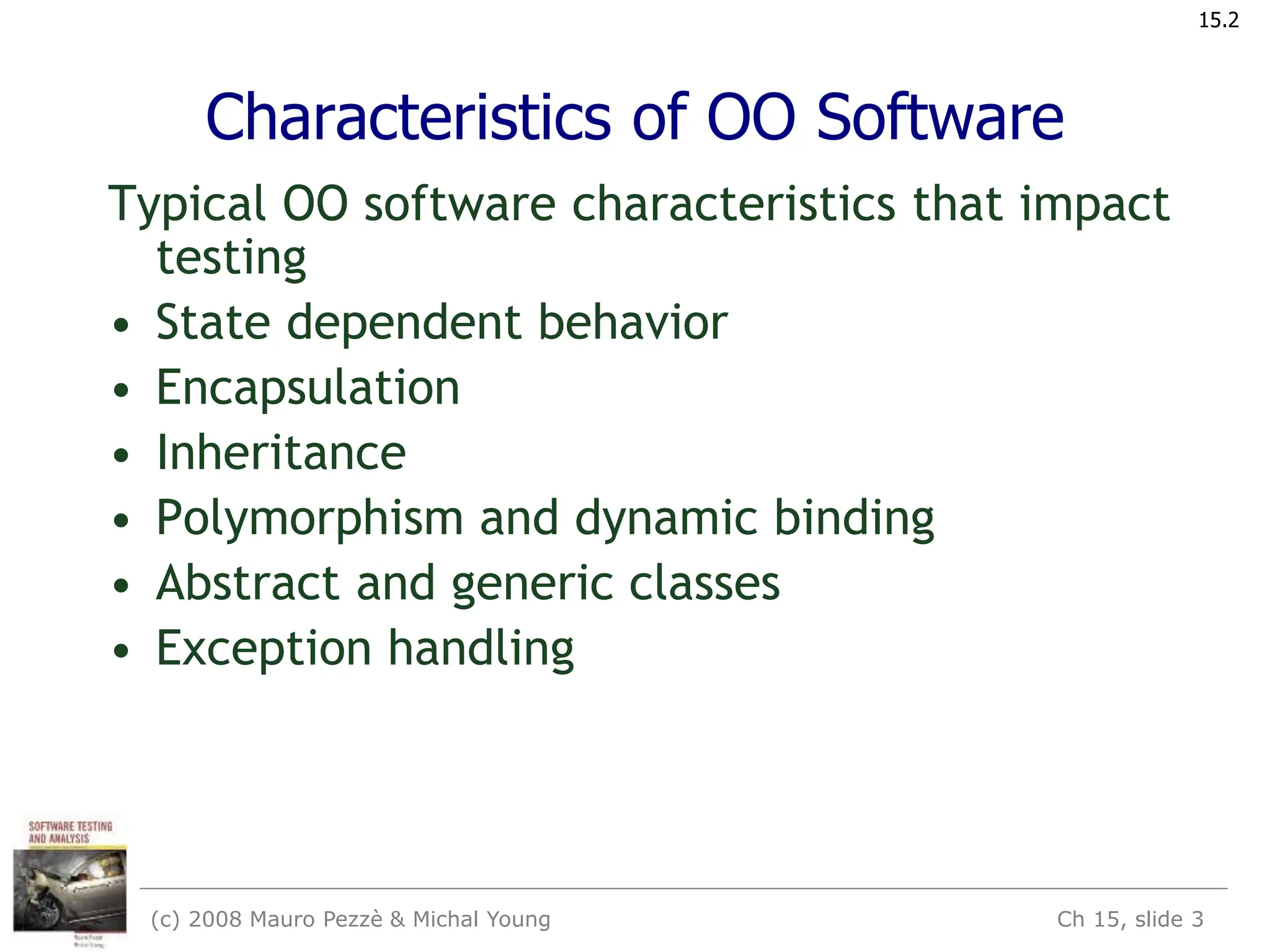
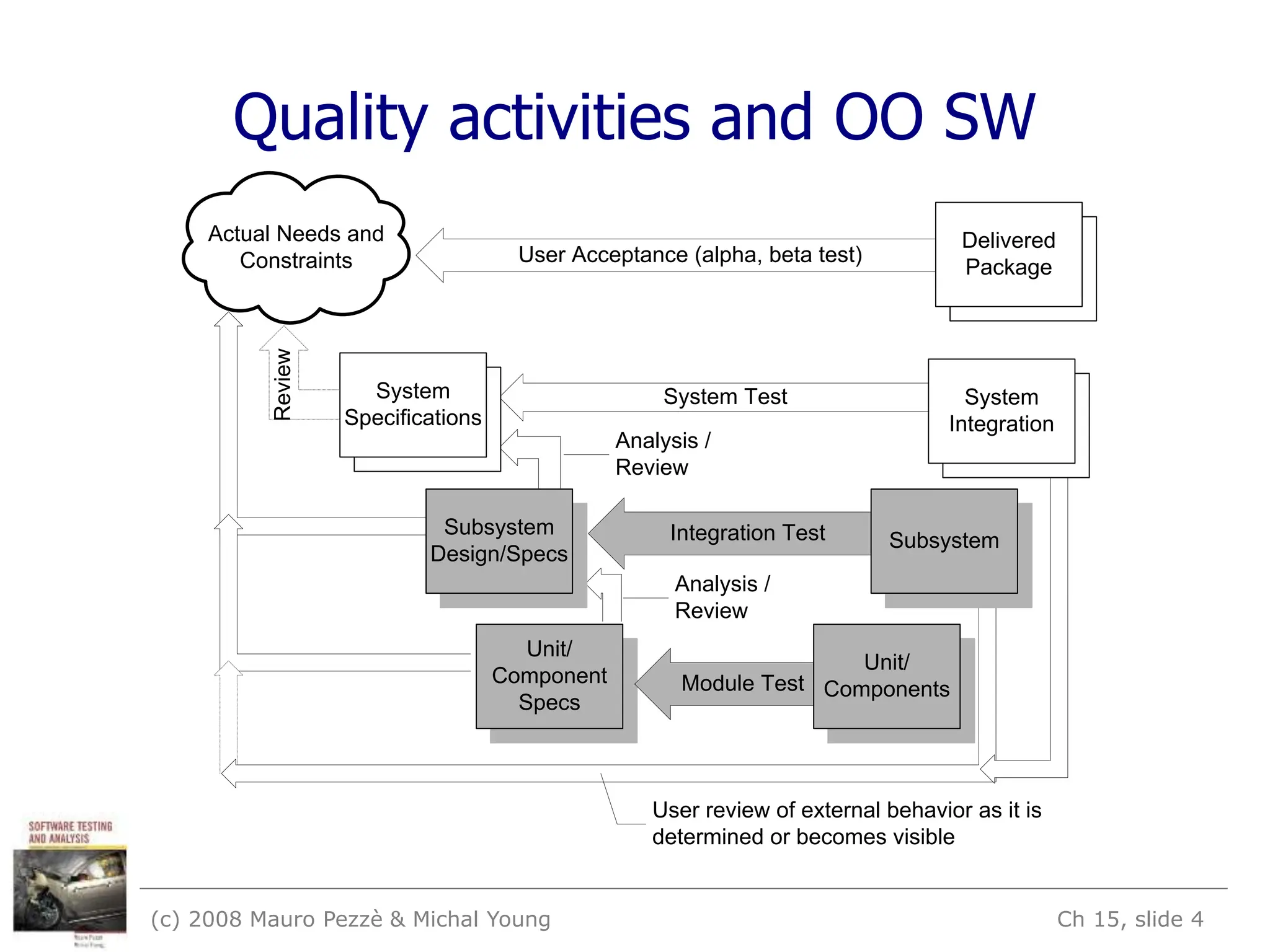
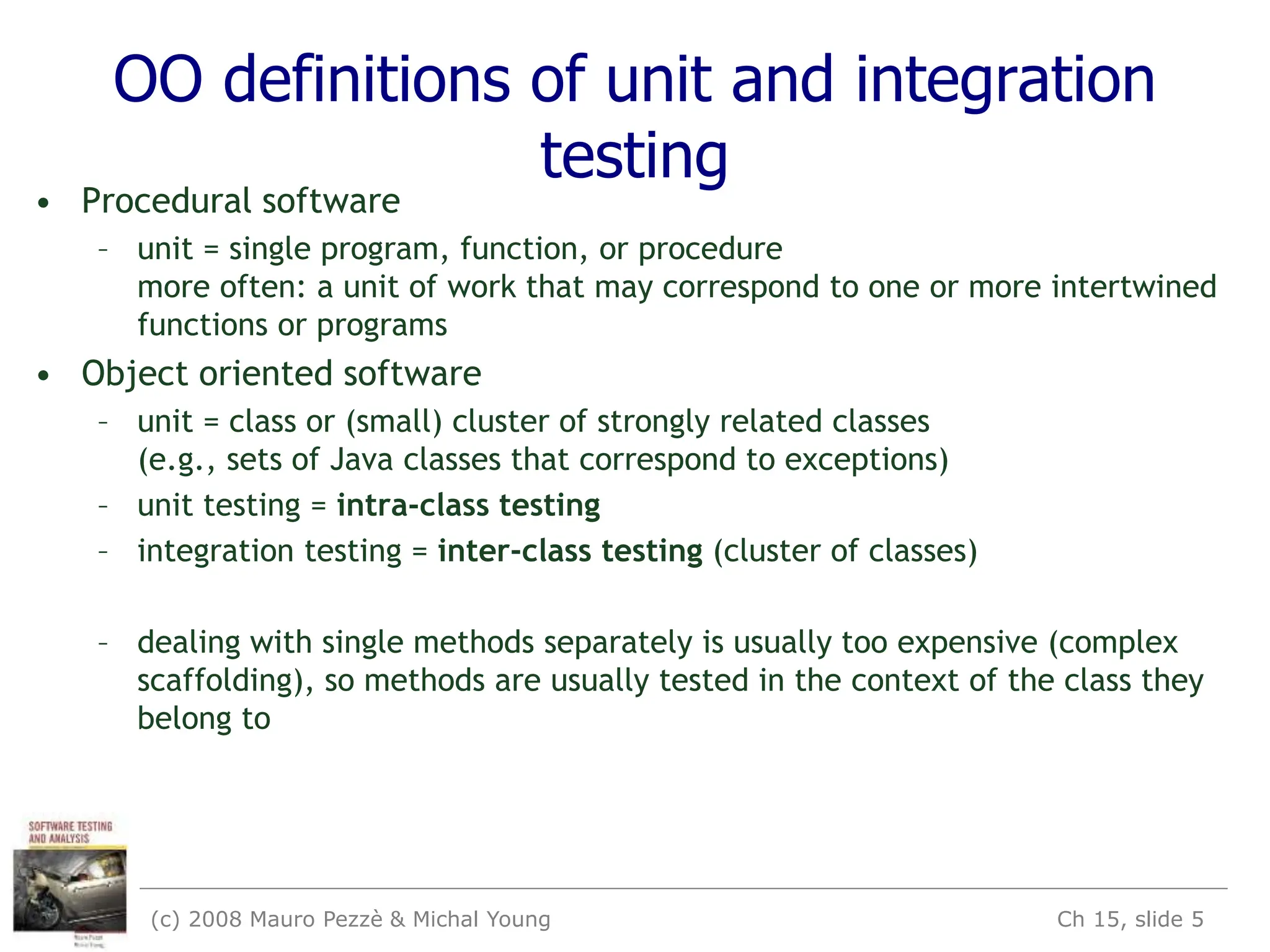
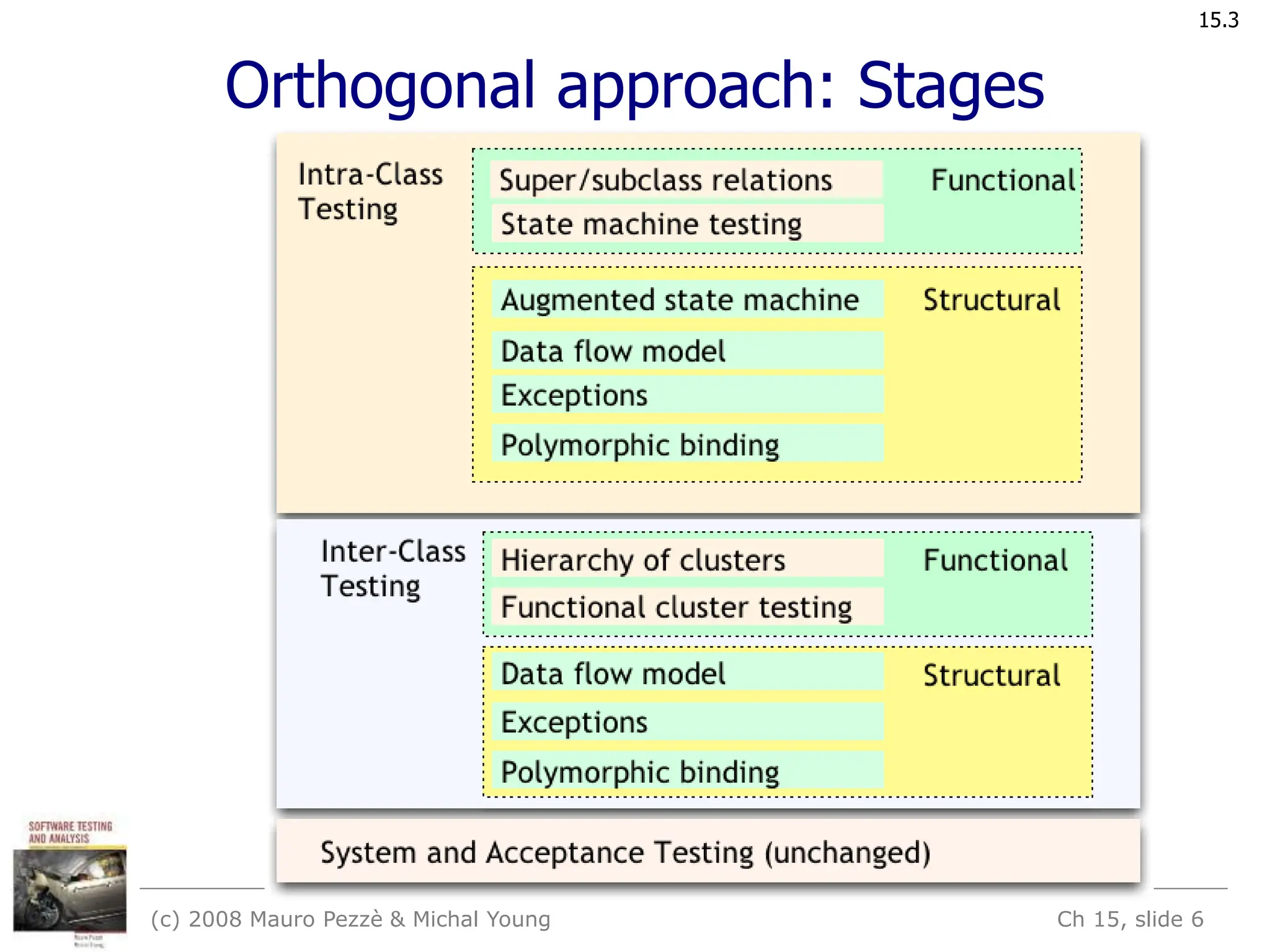
![(c) 2008 Mauro Pezzè & Michal Young
Intraclass State Machine Testing
• Basic idea:
– The state of an object is modified by operations
– Methods can be modeled as state transitions
– Test cases are sequences of method calls that
traverse the state machine model
• State machine model can be derived from
specification (functional testing), code
(structural testing), or both
[ Later: Inheritance and dynamic binding ]
15.4/5
Ch 15, slide 7](https://image.slidesharecdn.com/oot-240219093153-2aa00da6/75/object-oriented-testing-with-types-of-testing-7-2048.jpg)
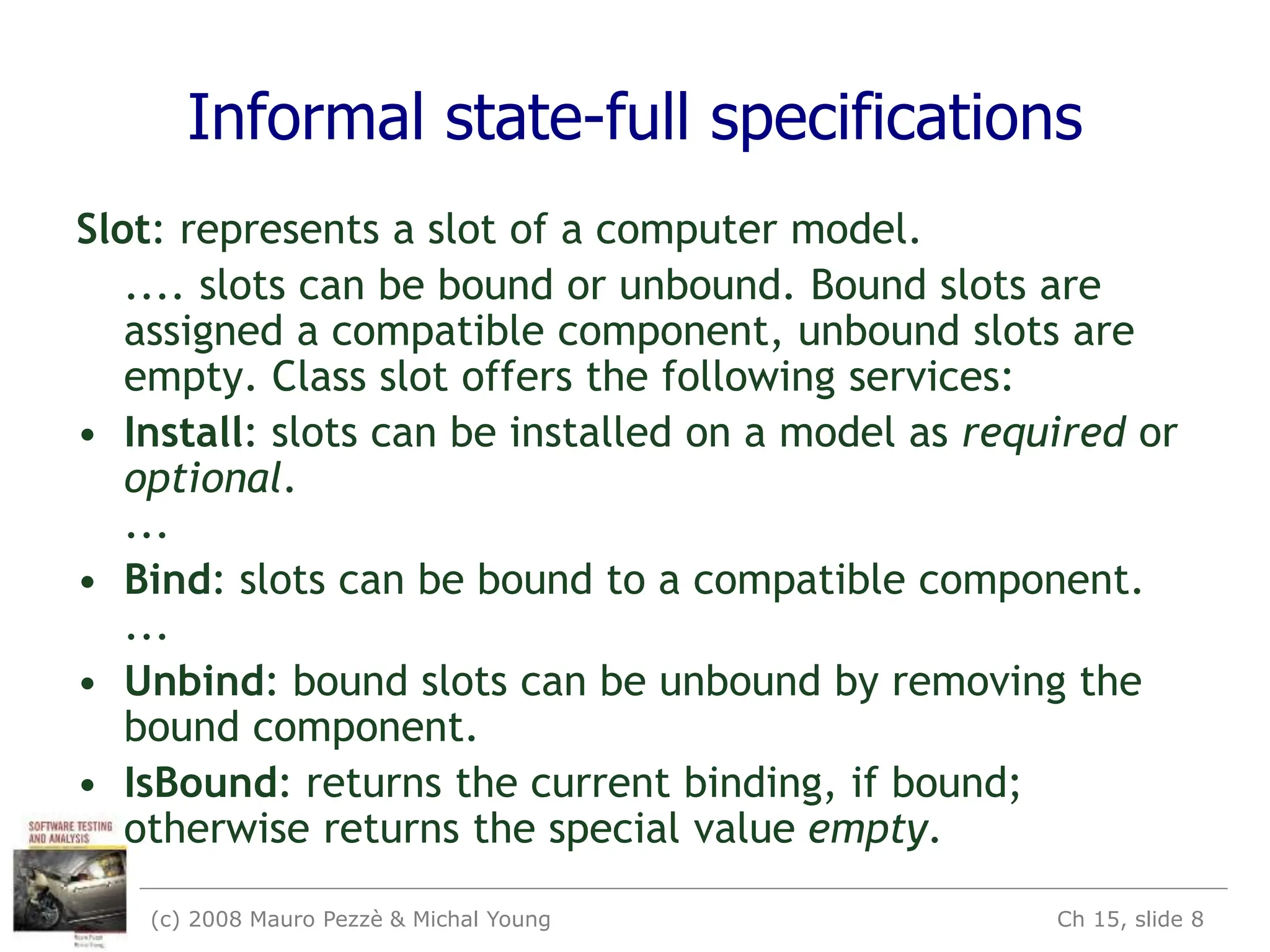
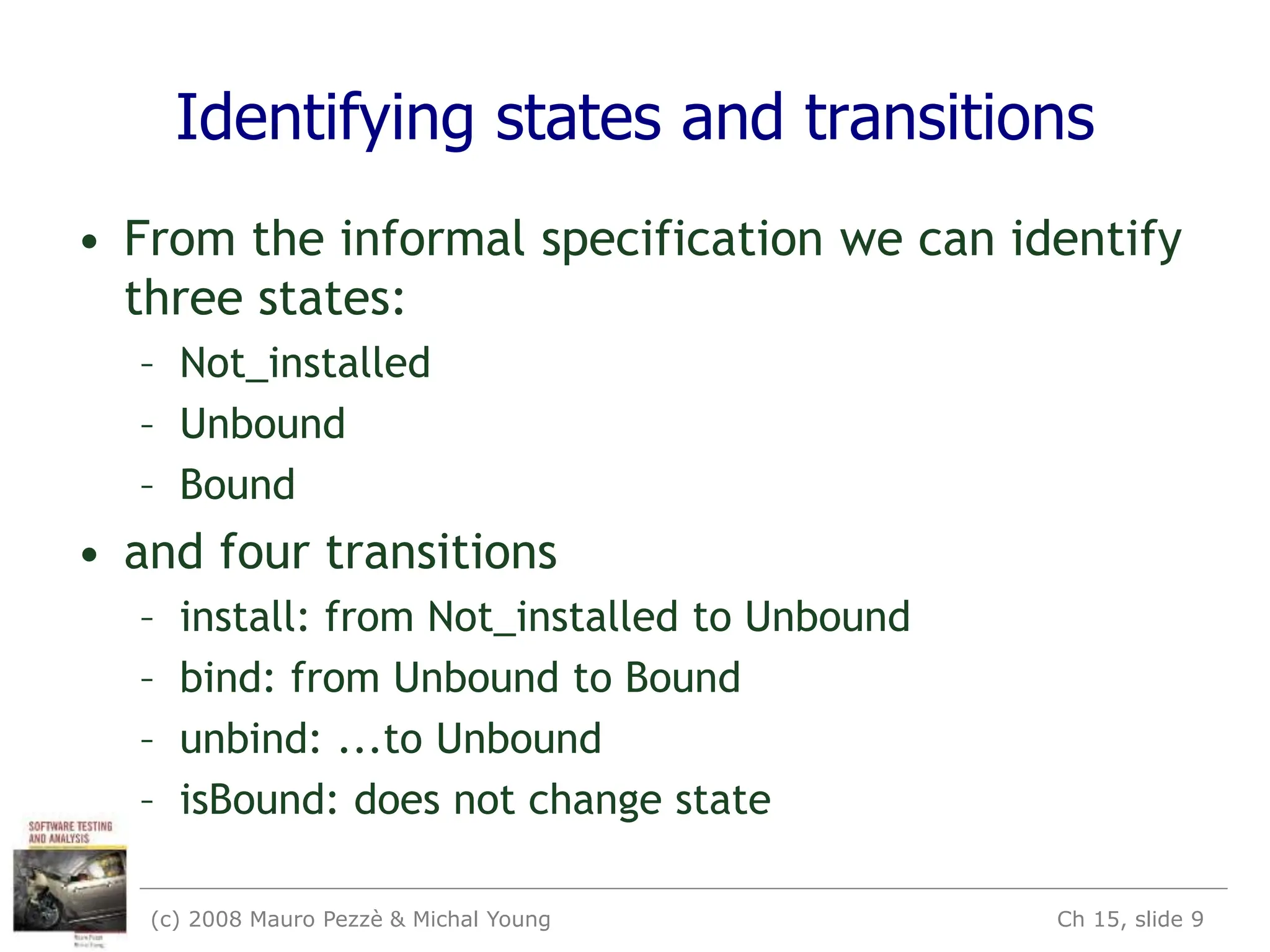

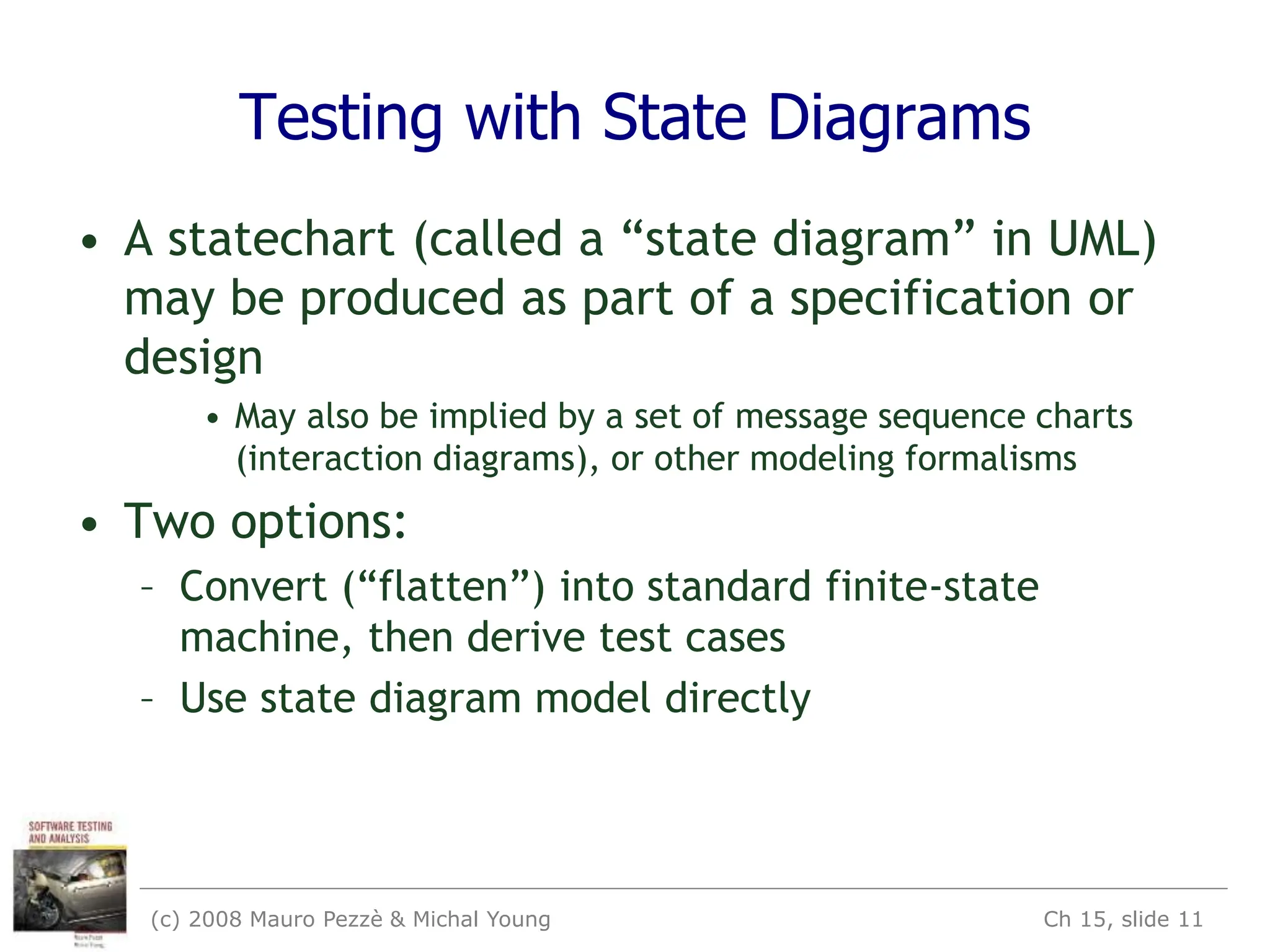
![(c) 2008 Mauro Pezzè & Michal Young
modelSelected
workingConfiguration
noModelSelected
validConfiguration
addComponent(slot, component)
_________________________
send mopdelDB: findComponent()
send slot:bind()
removeComponent(slot)
_________________________
send slot:unbind()
addComponent(slot, component)
_________________________
send Component_DB: get_component()
send slot:bind
deselectModel()
selectModel(model)
_________________
send modelDB: getModel(modelID,this)
removeComponent(slot)
_________________________
send slot:unbind()
isLegalConfiguration()
[legalConfig = true]
Statecharts specification
class model
method of
class Model
called by
class Model
super-state or
“OR-state”
Ch 15, slide 12](https://image.slidesharecdn.com/oot-240219093153-2aa00da6/75/object-oriented-testing-with-types-of-testing-12-2048.jpg)
![(c) 2008 Mauro Pezzè & Michal Young
From Statecharts to FSMs
workingConfiguration
noModelSelected
validConfiguration
addComponent(slot, component)
removeComponent(slot)
addComponent(slot, component)
deselectModel()
selectModel(model)
removeComponent(slot)
isLegalConfiguration()
[legalConfig=true]
deselectModel()
Ch 15, slide 13](https://image.slidesharecdn.com/oot-240219093153-2aa00da6/75/object-oriented-testing-with-types-of-testing-13-2048.jpg)
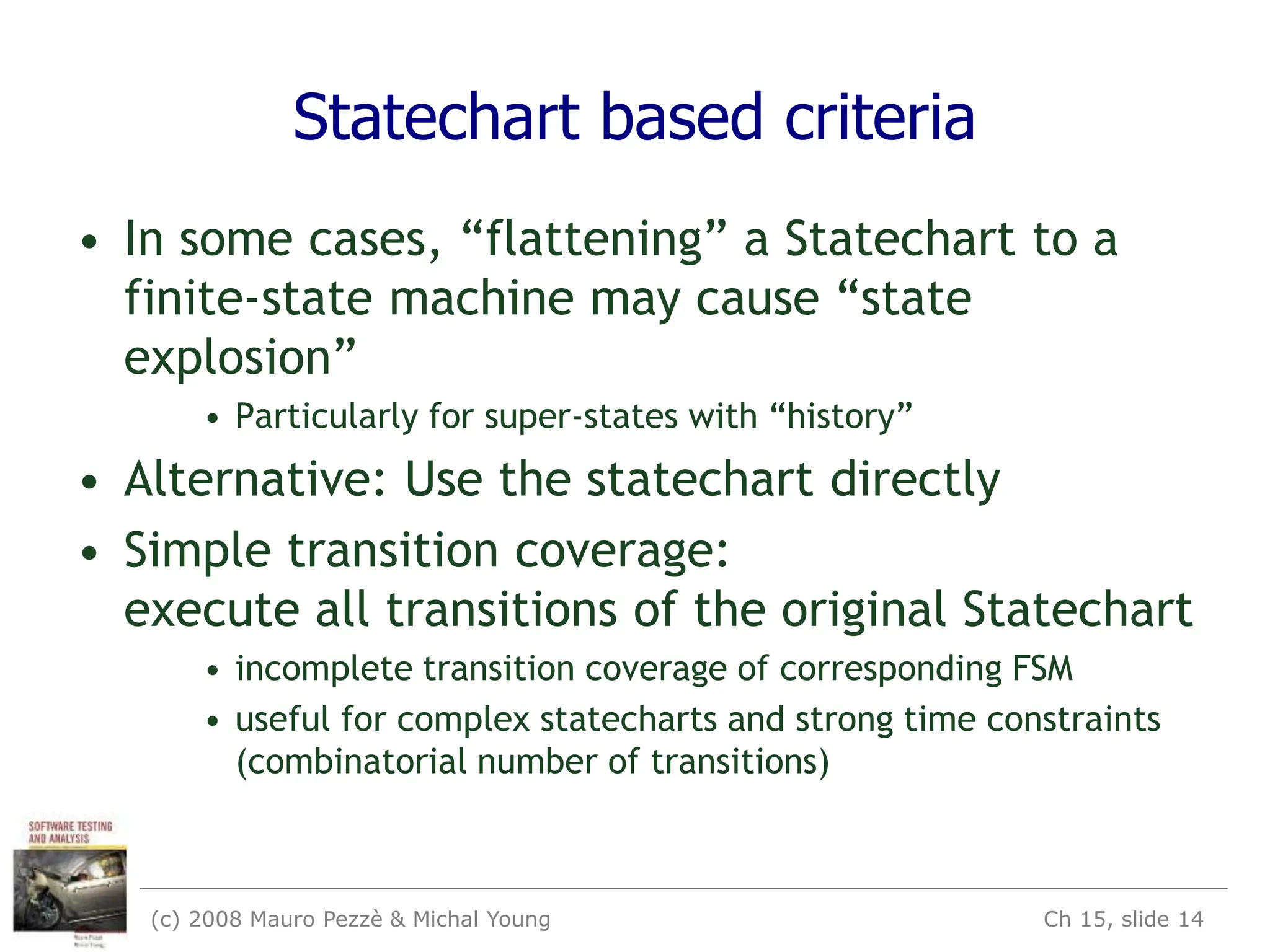

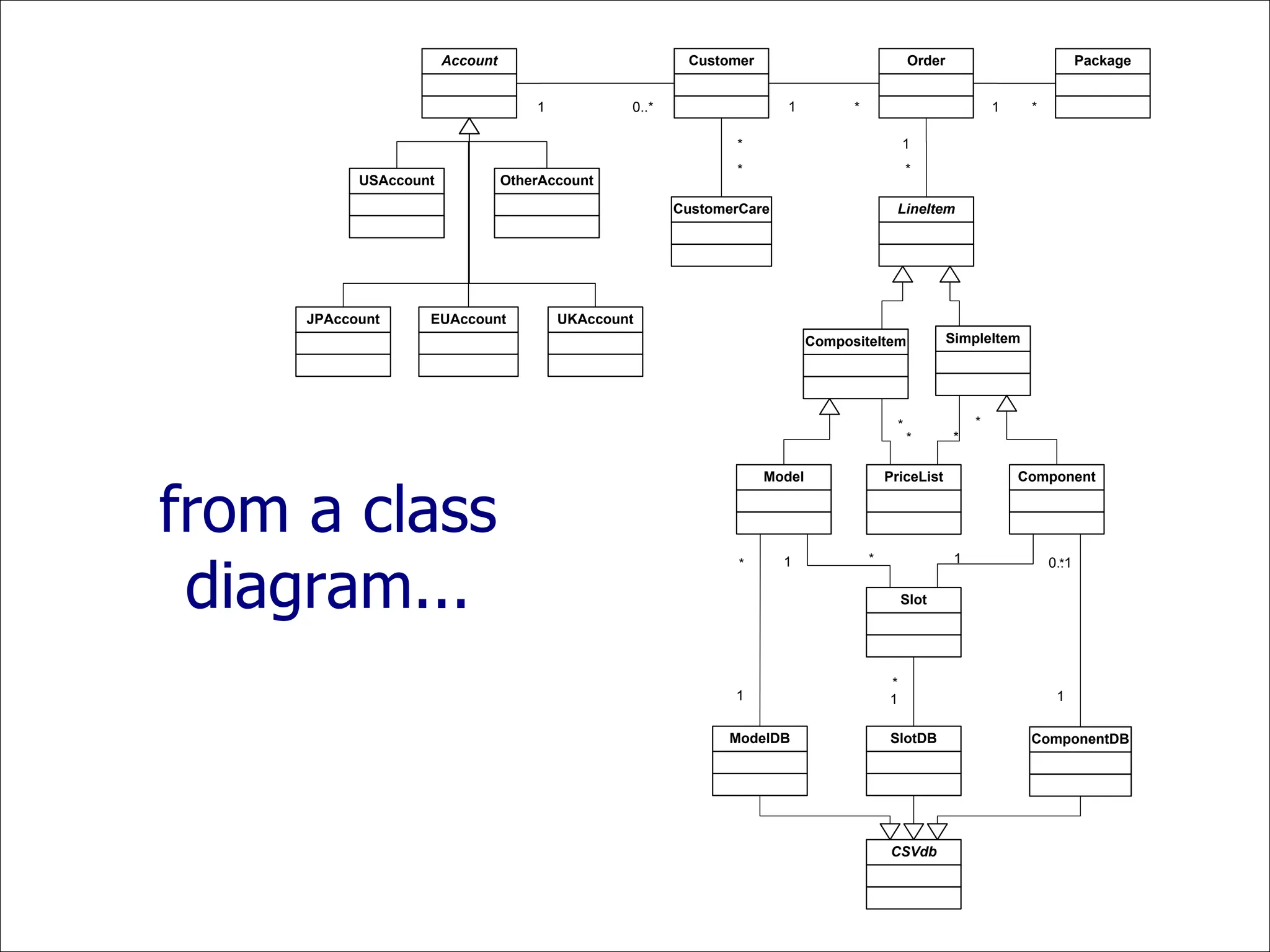
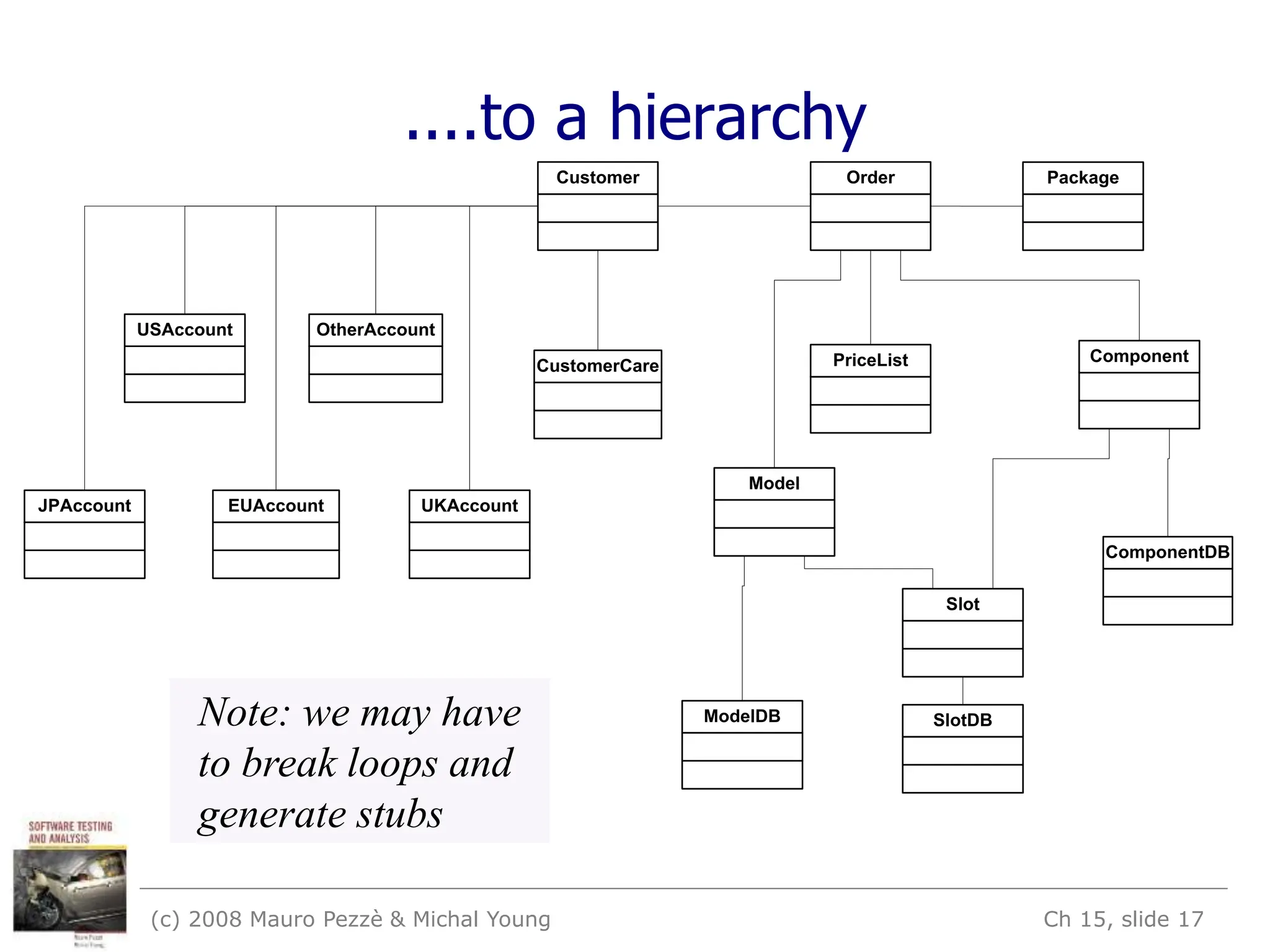
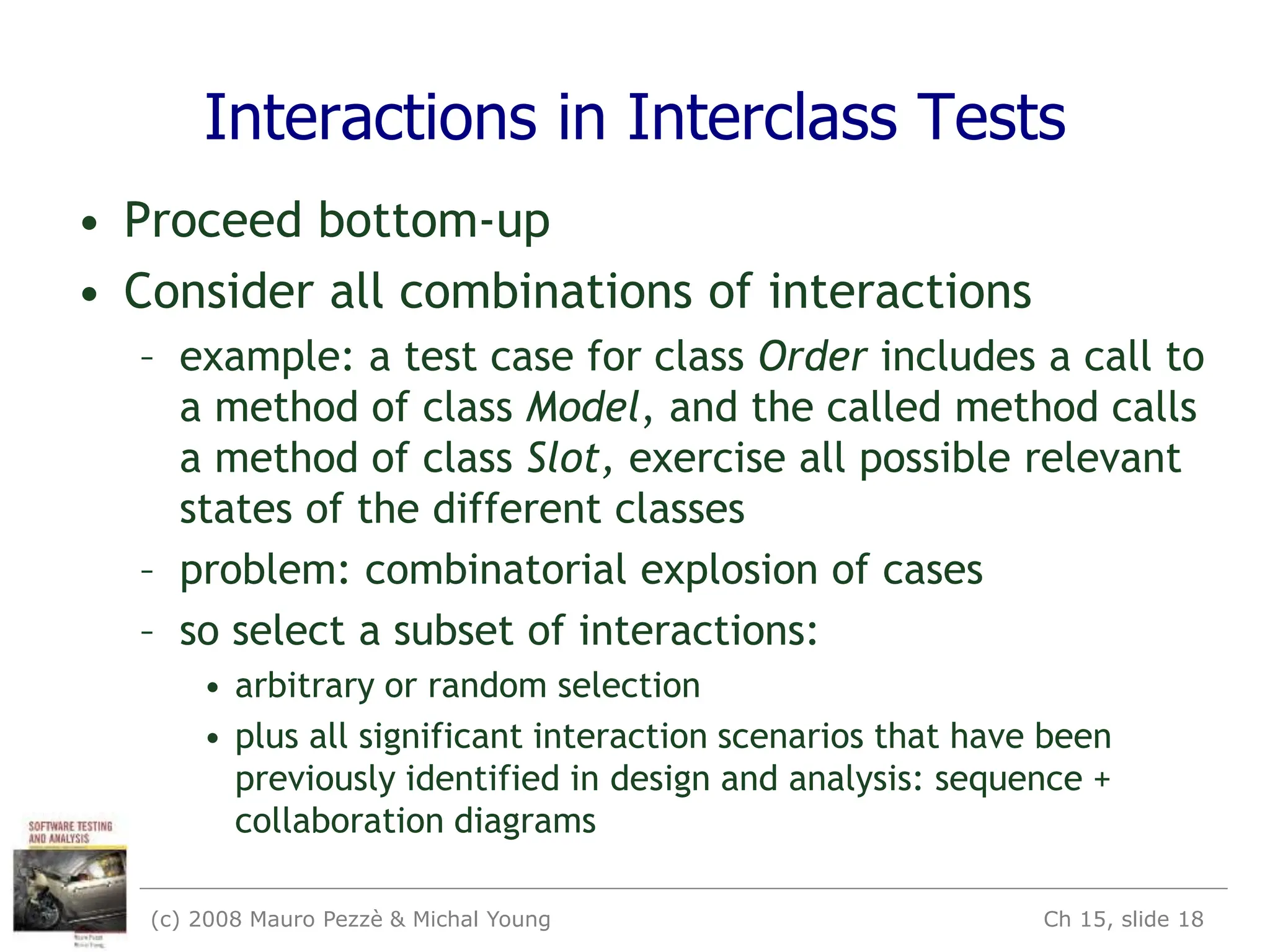
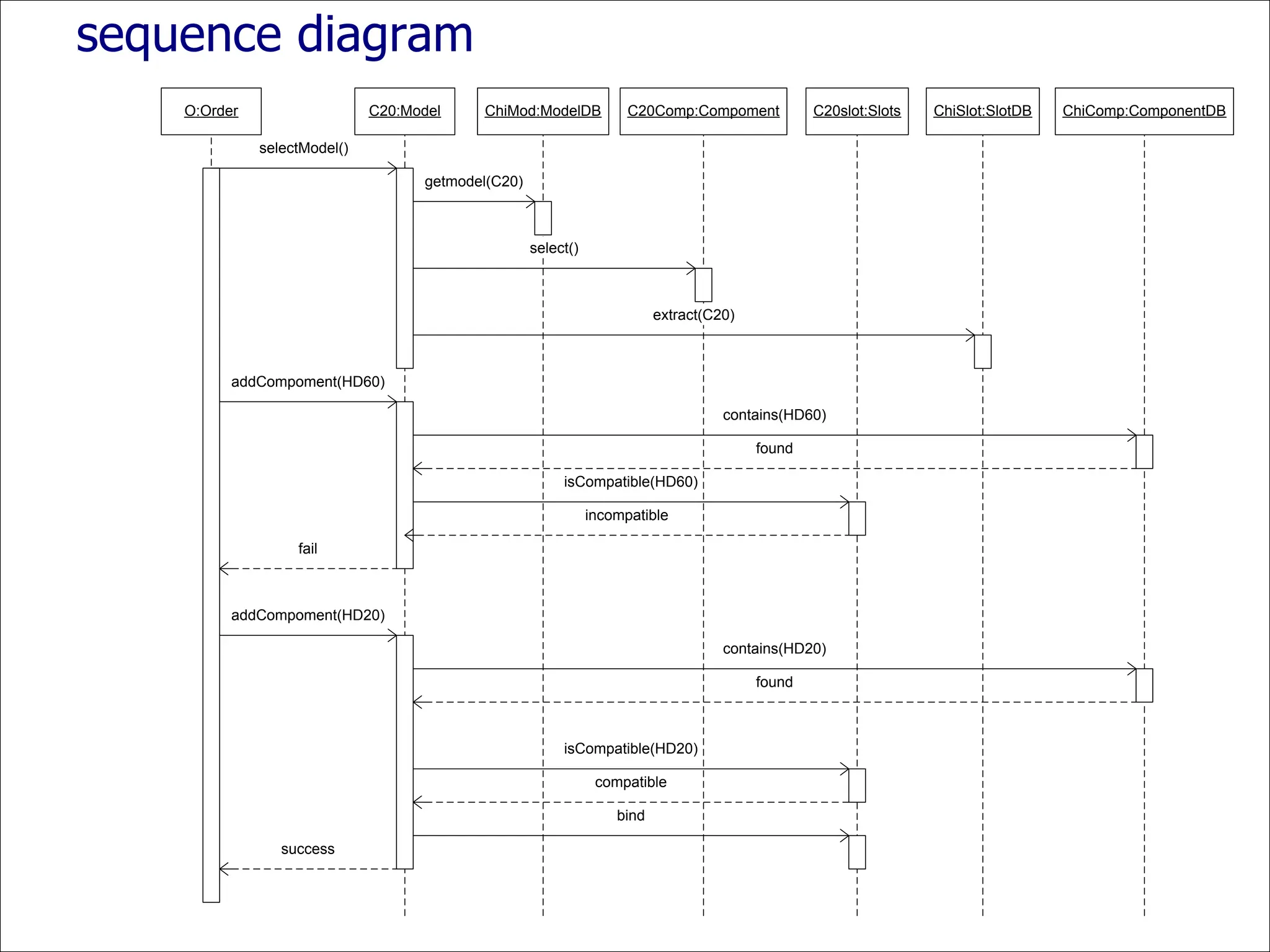
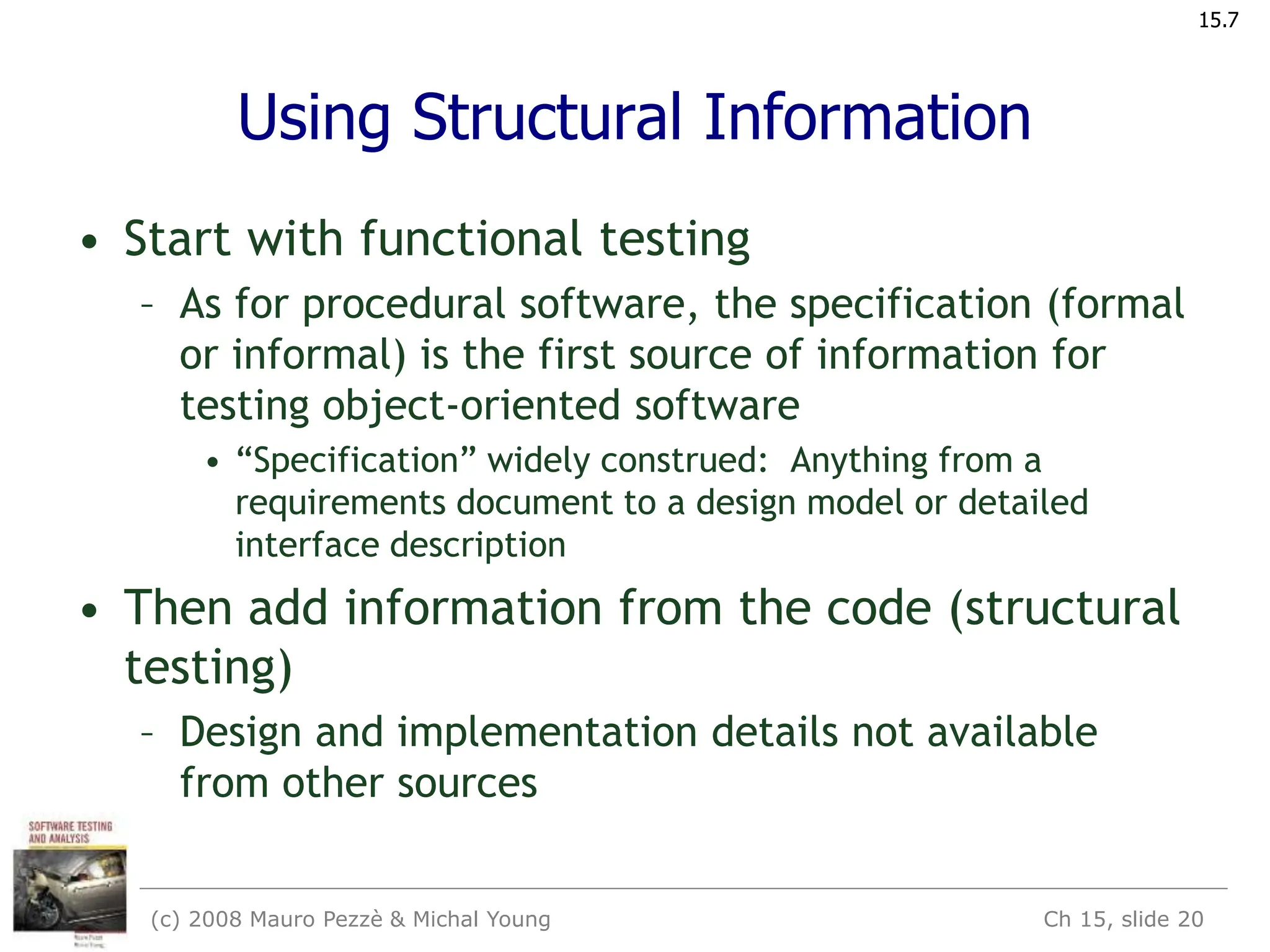
![(c) 2008 Mauro Pezzè & Michal Young
From the implementation ...
public class Model extends Orders.CompositeItem {
....
private boolean legalConfig = false; // memoized
....
public boolean isLegalConfiguration() {
if (! legalConfig) {
checkConfiguration();
}
return legalConfig;
}
.....
private void checkConfiguration() {
legalConfig = true;
for (int i=0; i < slots.length; ++i) {
Slot slot = slots[i];
if (slot.required && ! slot.isBound()) {
legalConfig = false;
} ...} ... }
......
private instance
variable
private method
Ch 15, slide 21](https://image.slidesharecdn.com/oot-240219093153-2aa00da6/75/object-oriented-testing-with-types-of-testing-21-2048.jpg)
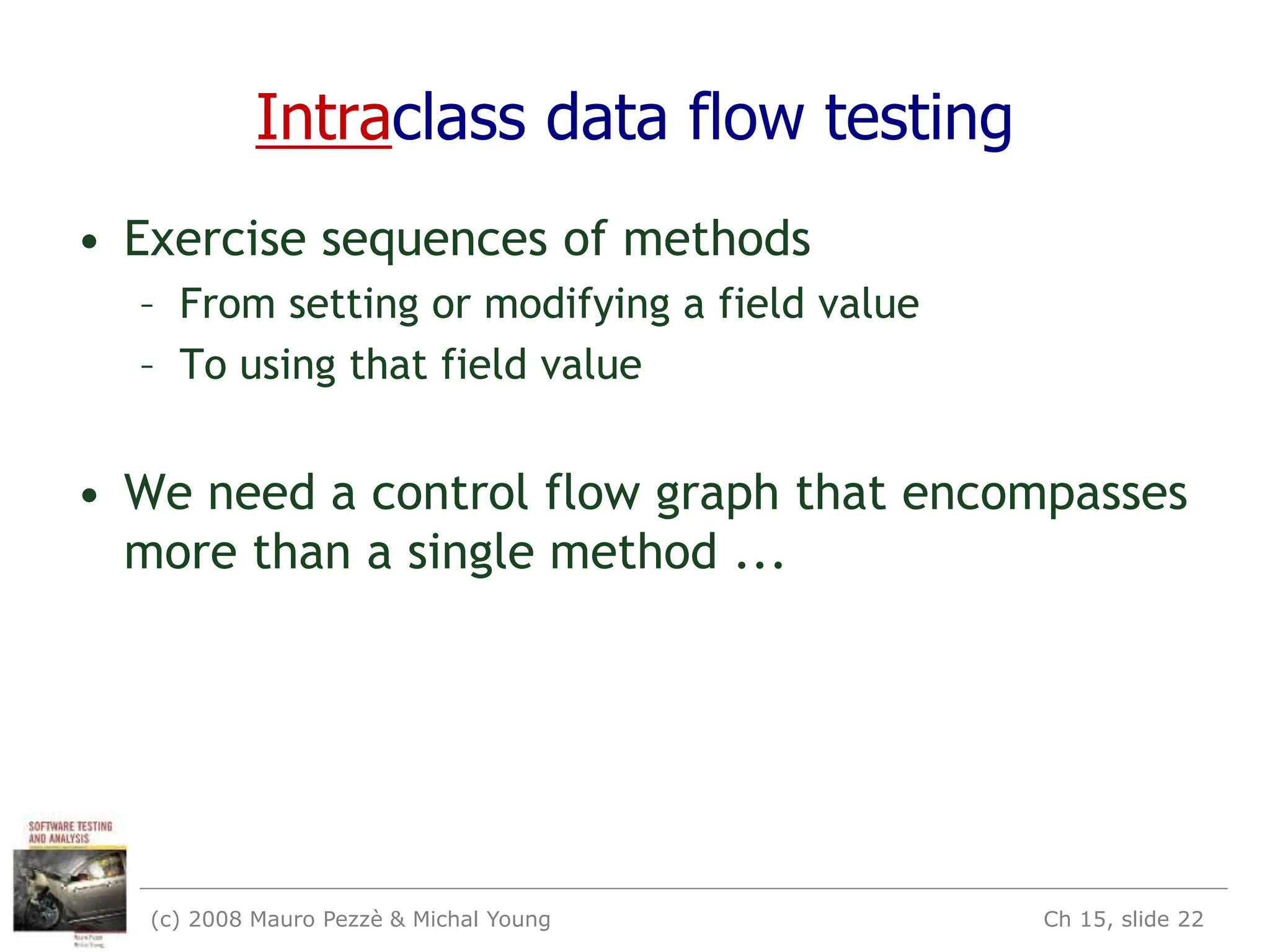
![(c) 2008 Mauro Pezzè & Michal Young
The intraclass control flow graph
Control flow for each method
+
node for class
+
edges
from node class to the start
nodes of the methods
from the end nodes of the
methods to node class
=> control flow through sequences
of method calls
Model() 1.1
modelID = NoModel 1.4
exit Model 1.5
boolean legalConfig = false 1.2
ModelDB modelDB = null 1.3
void selectModel(String modelID) 2.1
openDB() 2.2
exit selectModel 2.4
modelDB.getModel(modelID, this) 2.3
void deselectModel() 3.1
modelID = NoModel 3.2
slot = null 3.4
longName = “No ...selected.” 3.3
exit deselectModel 3.5
void removeComponent(int slotIndex) 5.1
slots[slotIndex].unbind() 5.3
if (slots[slotIndex].isBound() 5.2
legalConfig = false 5.4
True
False
exit removeComponent 5.5
void checkConfiguration() 6.1
i < slot.length
if (slot.required && ! slot.isBound()
Slot slot = slots[i]
6.4
legalConfig = false
legalConfig = true
exit checkConfiguration
False
True
++i
int i = 0
True
False
6.3
6.5
6.6
6.7
6.8
6.2
6.9
class
Model
void addComponent(int slotIndex, String sku) 4.1
exit addCompoment 4.10
slot.bind(comp) 4.7
Component comp = new Component(order, sku) 4.3
slot.unbind(); 4.5
legalConfig = false; 4.6
(componentDB.contains(sku)) 4.2
True
(comp.isCompatible(slot.slotID)) 4.4
True
False
False
slot.unbind(); 4.8
legalConfig = false; 4.9
boolean isLegalConfiguration() 7.1
checkCongfiguration()
if (!isLegalConfig)
7.3
True
False
7.2
return legalConfig 7.4
class Model
Method
addComponent
Method
selectModel
Method
checkConfiguration
Ch 15, slide 23](https://image.slidesharecdn.com/oot-240219093153-2aa00da6/75/object-oriented-testing-with-types-of-testing-23-2048.jpg)
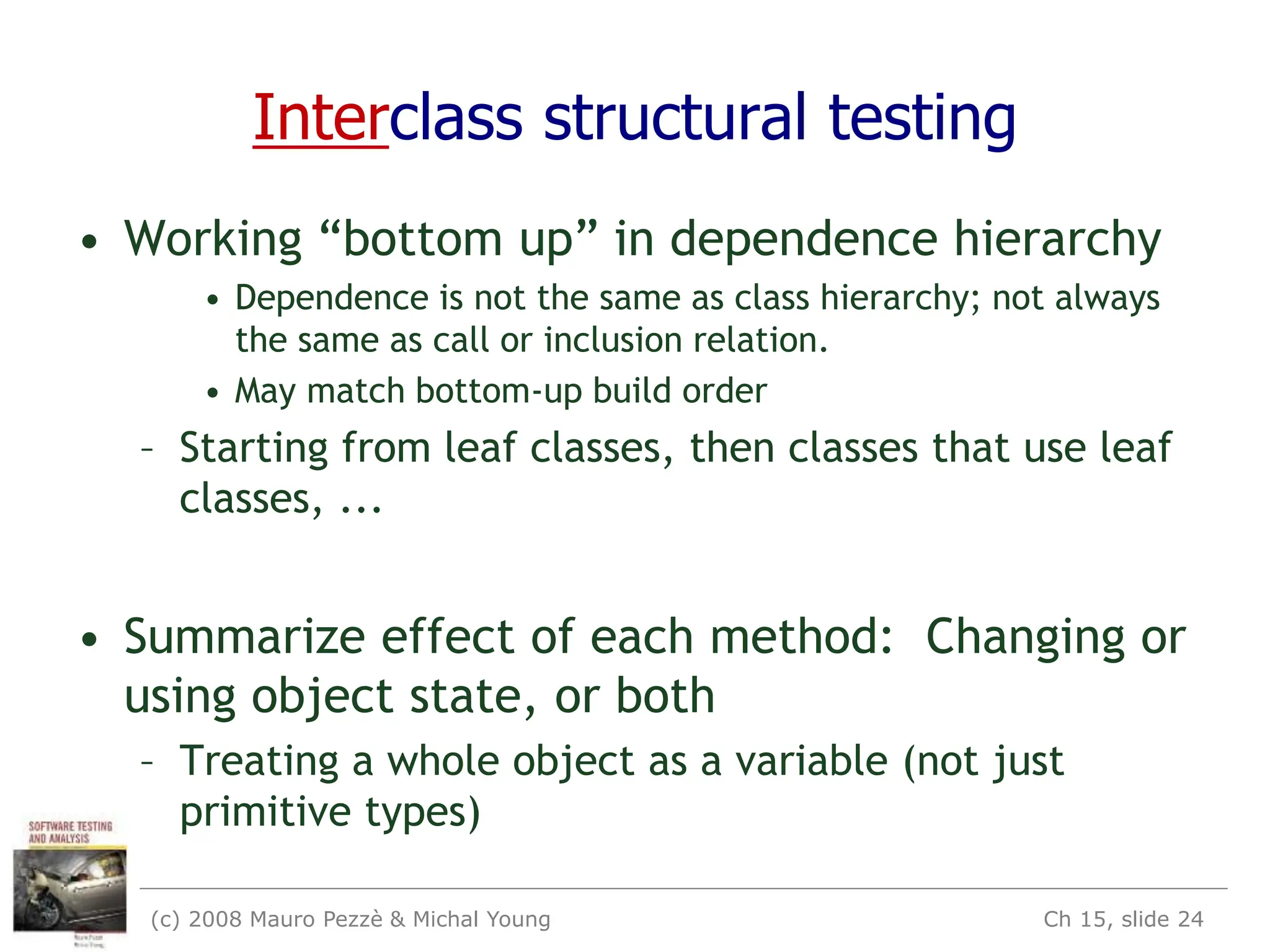
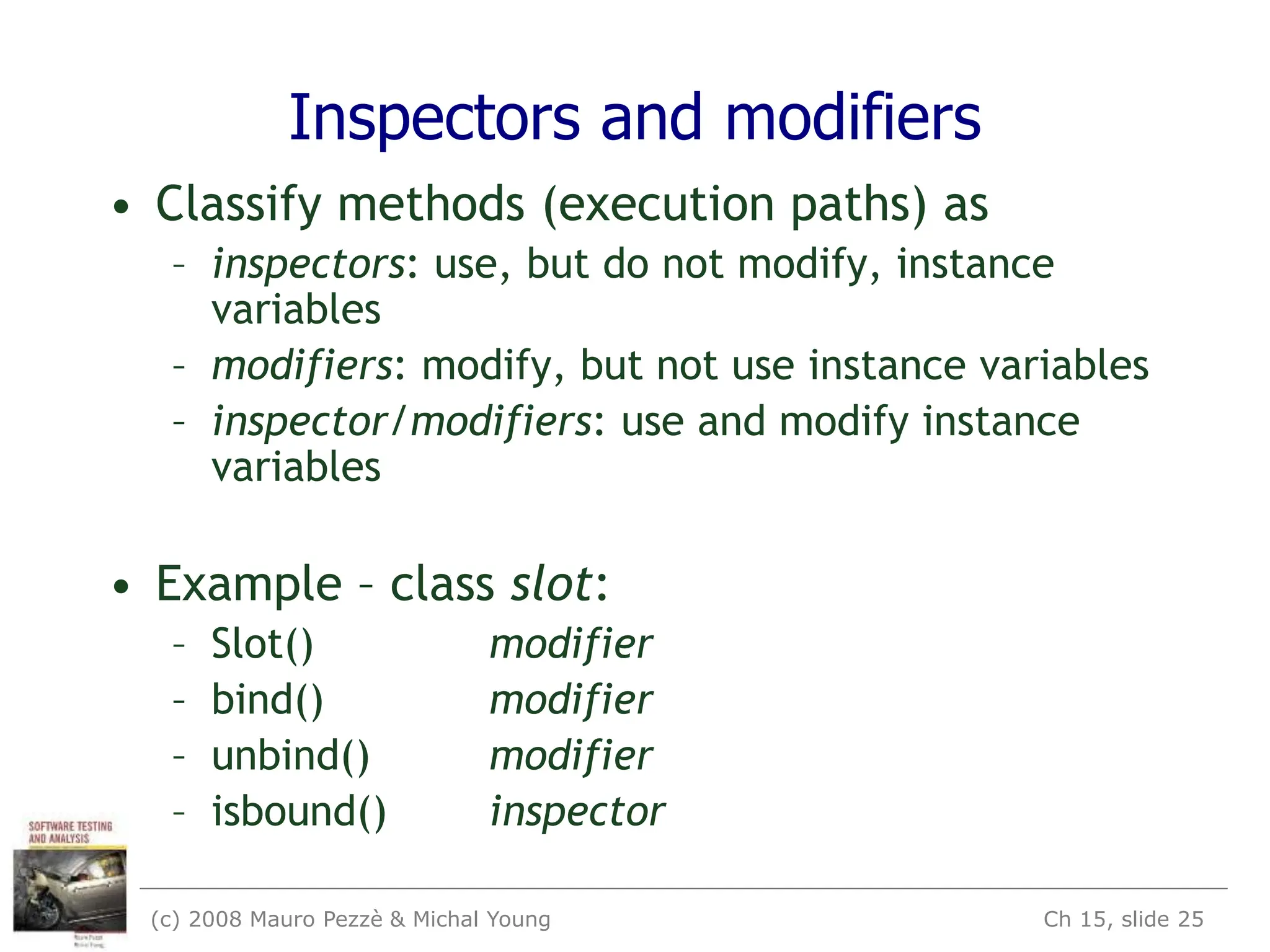
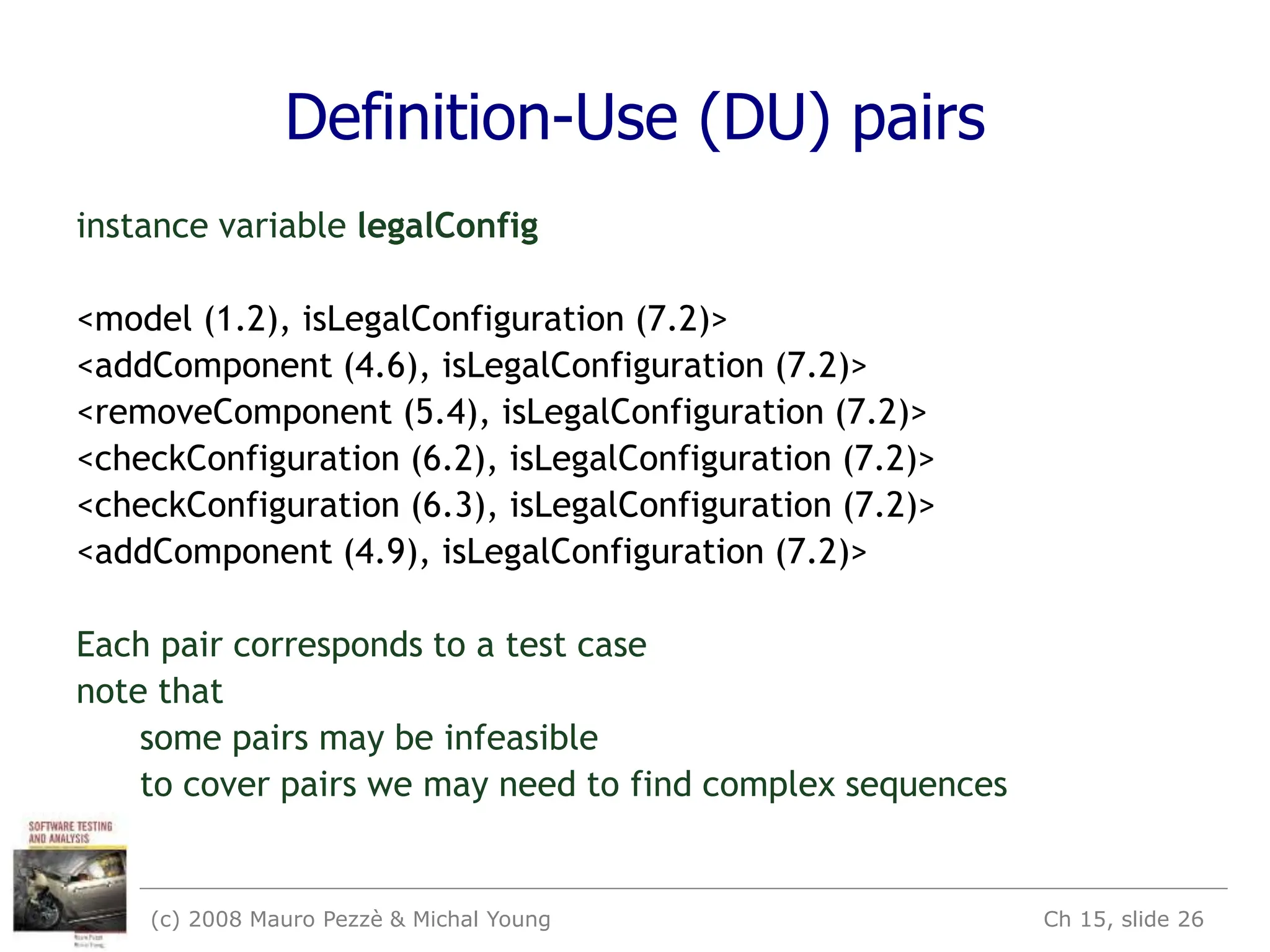

![(c) 2008 Mauro Pezzè & Michal Young
Uses from inspectors
Uses of instance
variables slot in class
model
removeComponent (5.2)
checkConfiguration (6.4)
checkConfiguration (6.5)
checkConfiguration (6.7)
void checkConfiguration() 6.1
i < slot.length
if (slot.required && ! slot.isBound()
Slot slot = slots[i]
6.4
legalConfig = false
legalConfig = true
exit checkConfiguration
False
True
++i
int i = 0
True
False
6.3
6.5
6.6
6.7
6.8
6.2
6.9
Slot() modifier
bind() modifier
unbind() modifier
isbound() inspector
Slot slot =slots[slotIndex];
Ch 15, slide 28](https://image.slidesharecdn.com/oot-240219093153-2aa00da6/75/object-oriented-testing-with-types-of-testing-28-2048.jpg)
